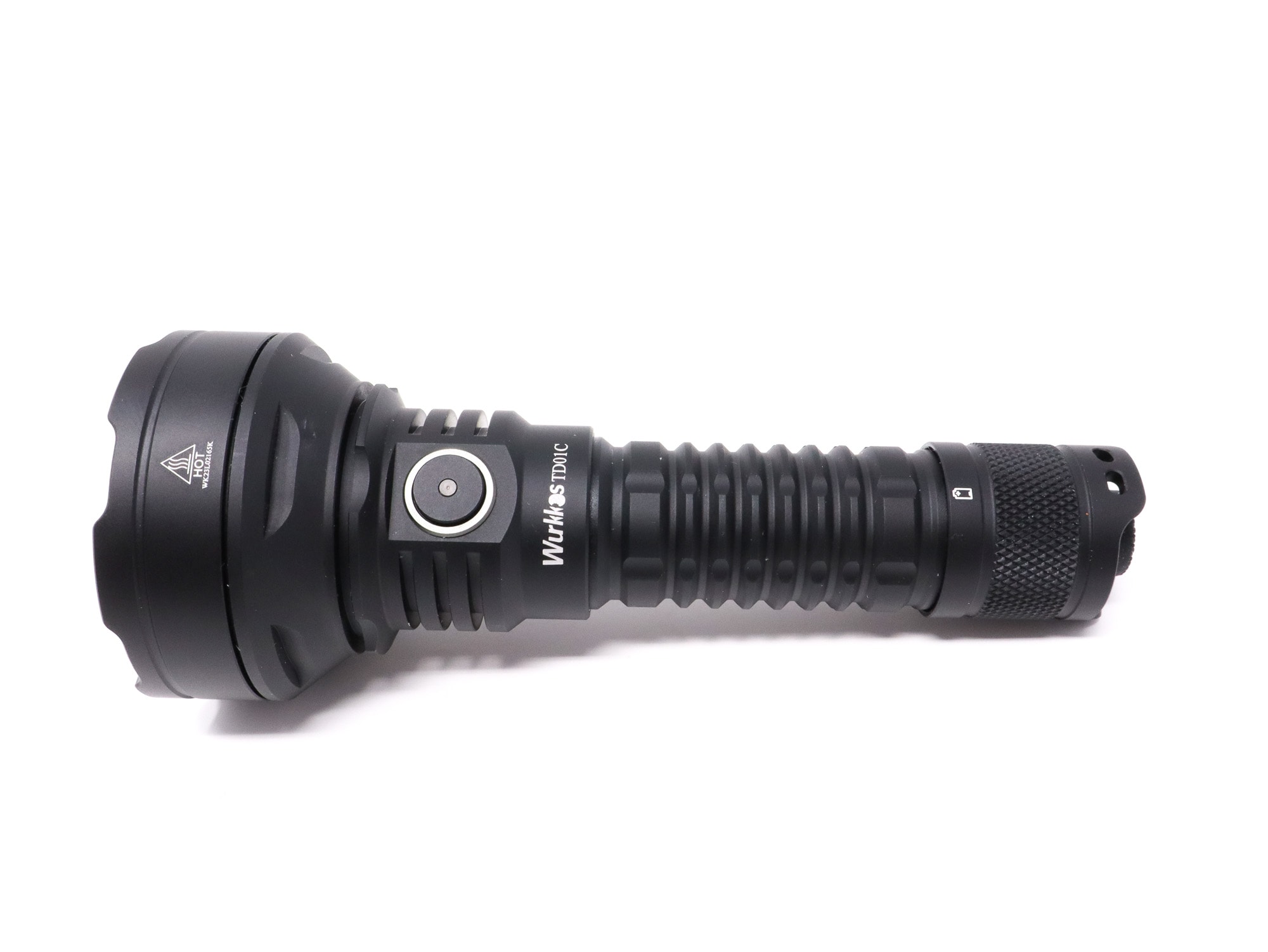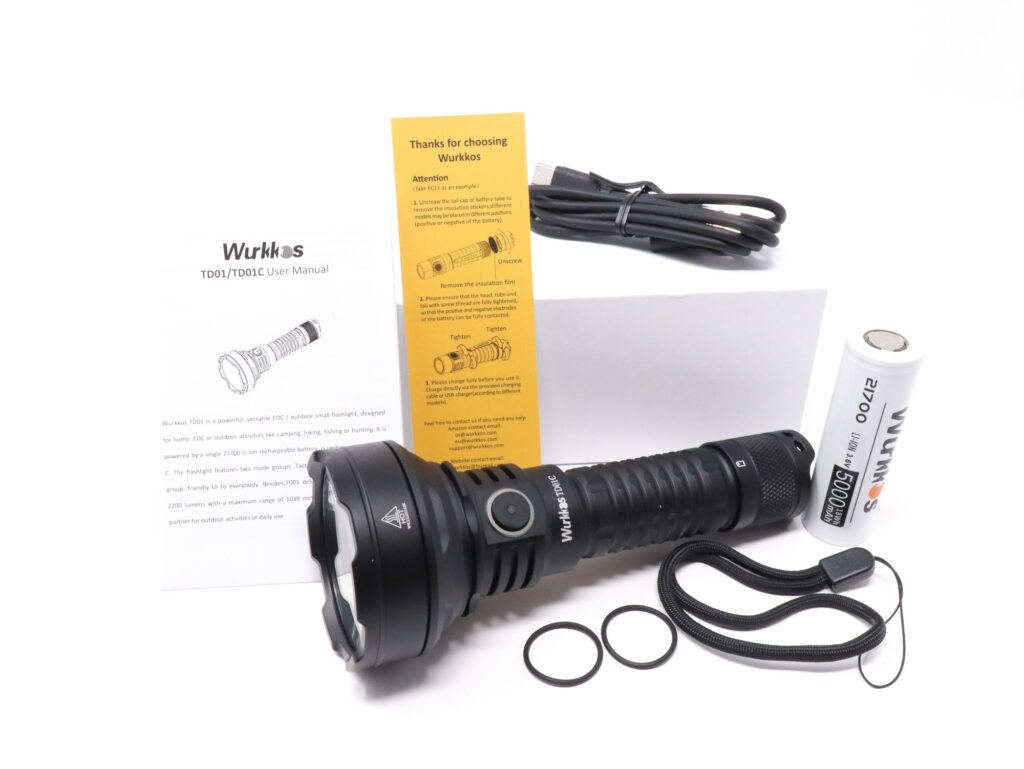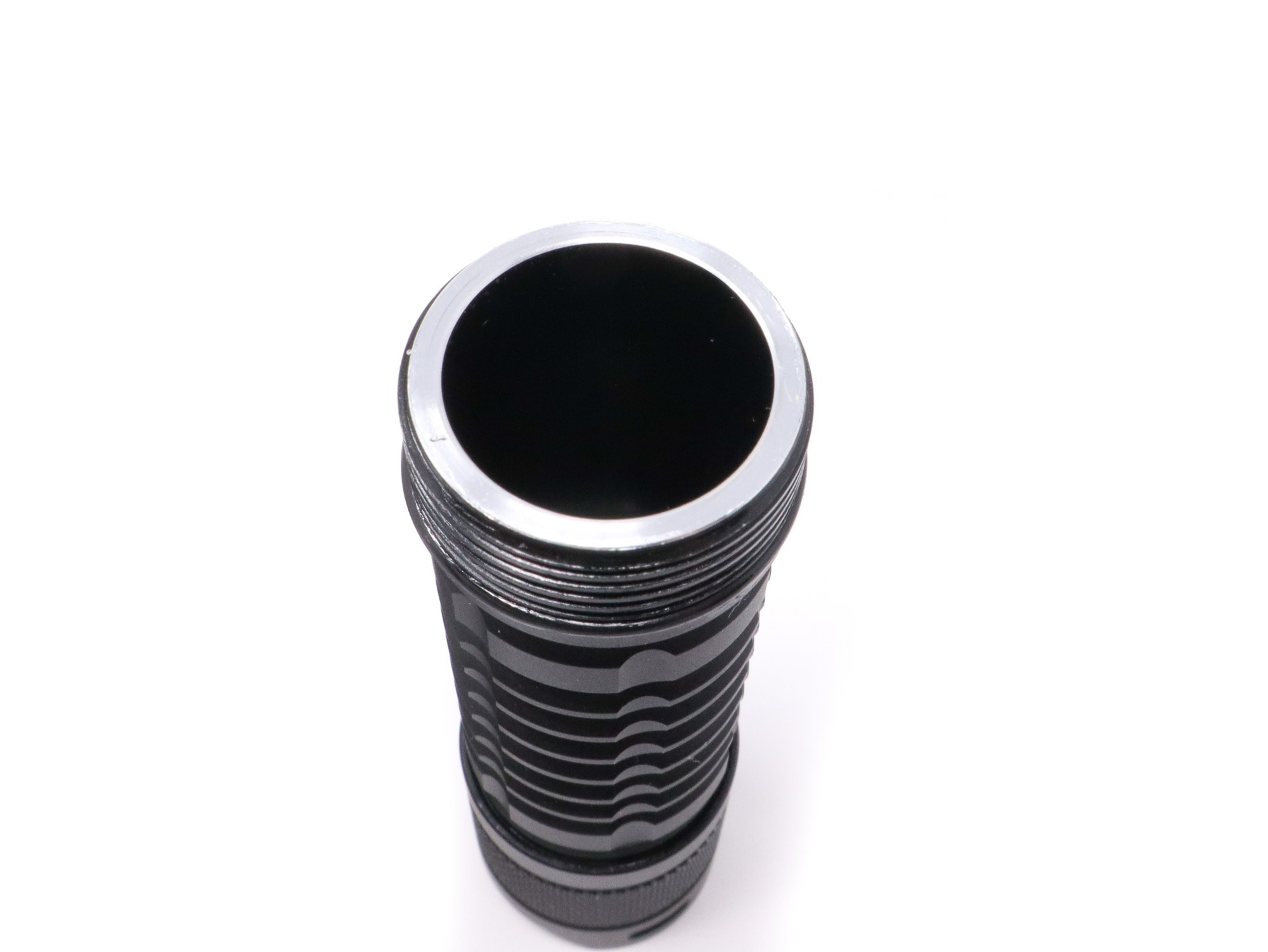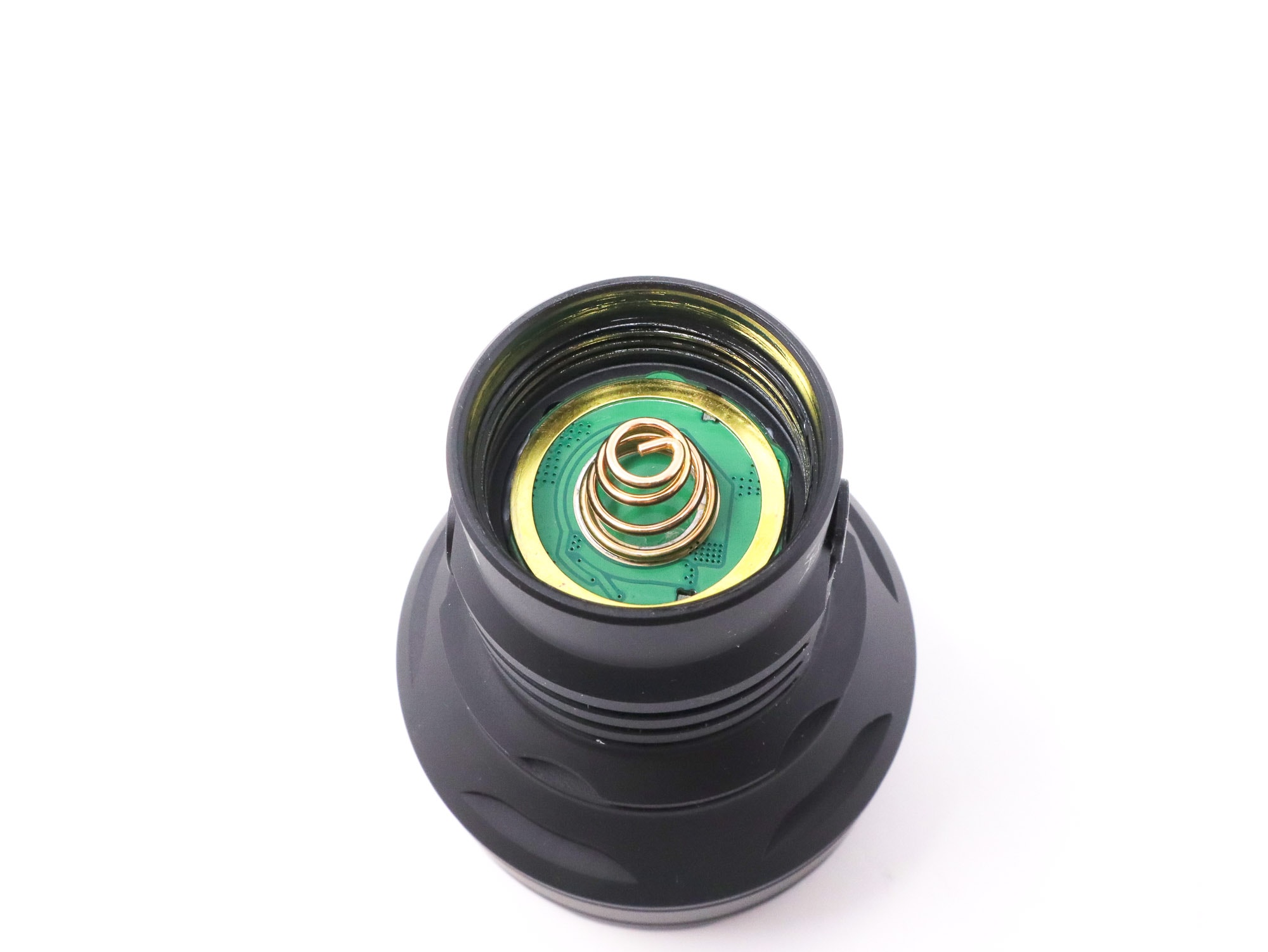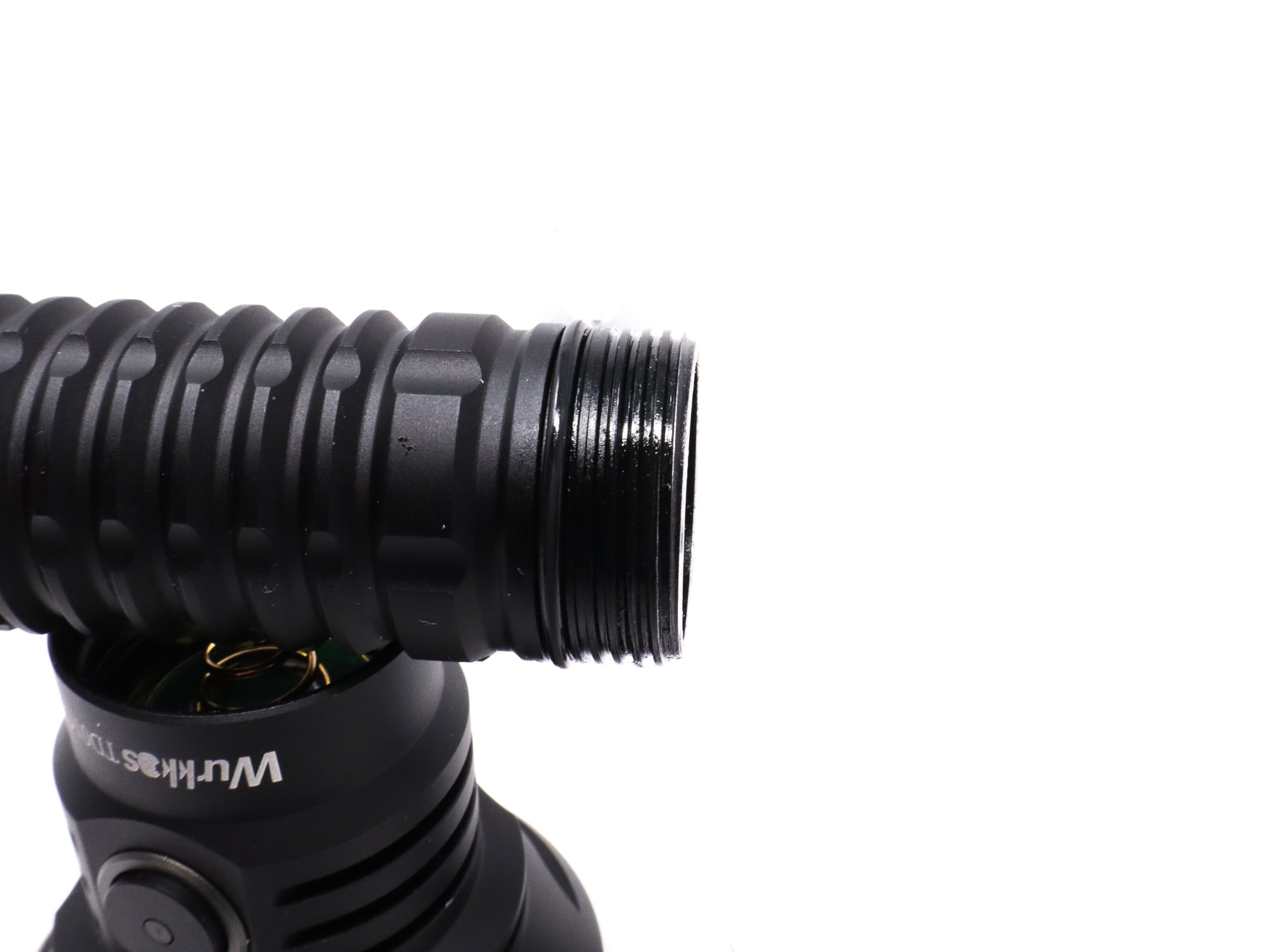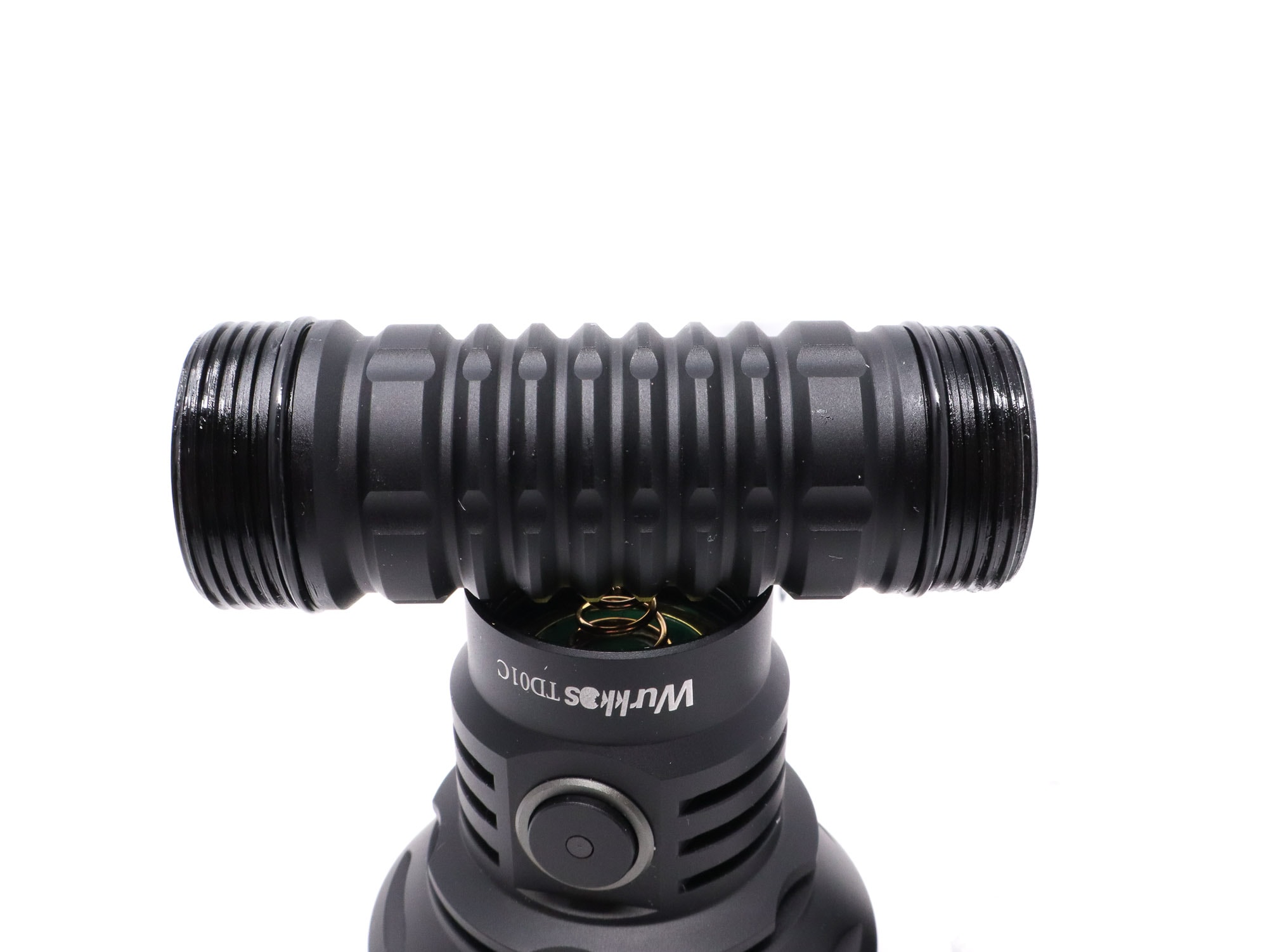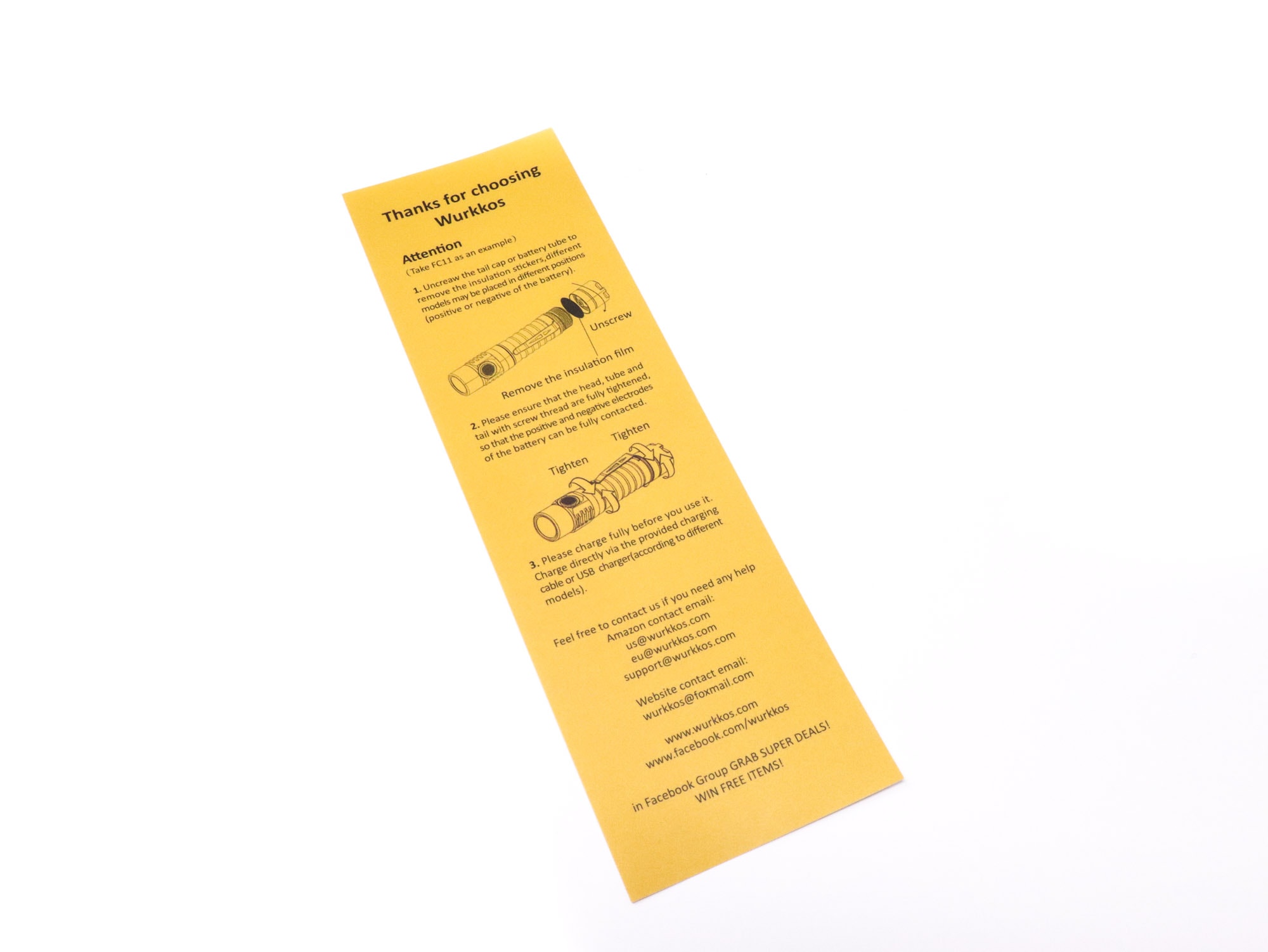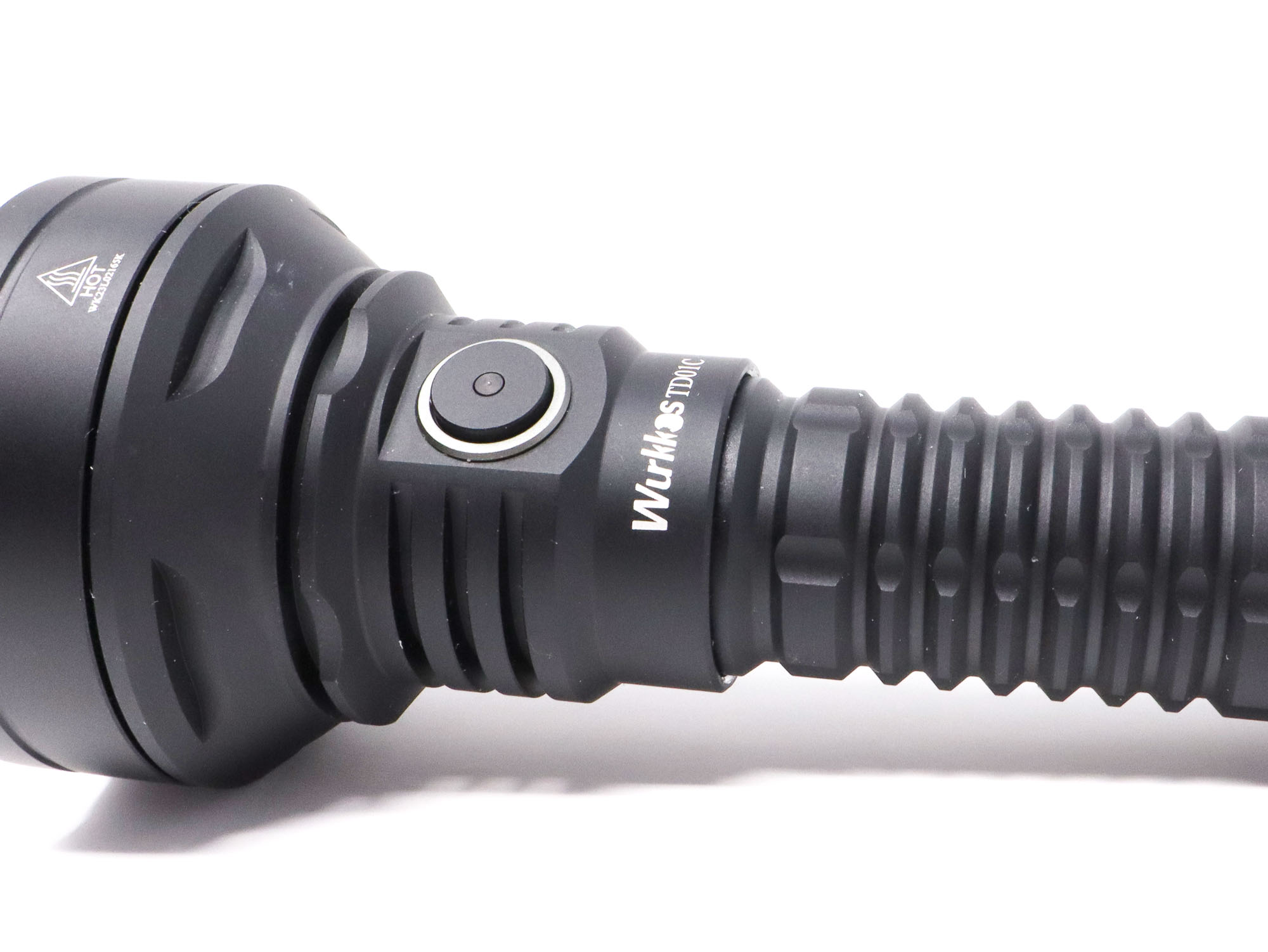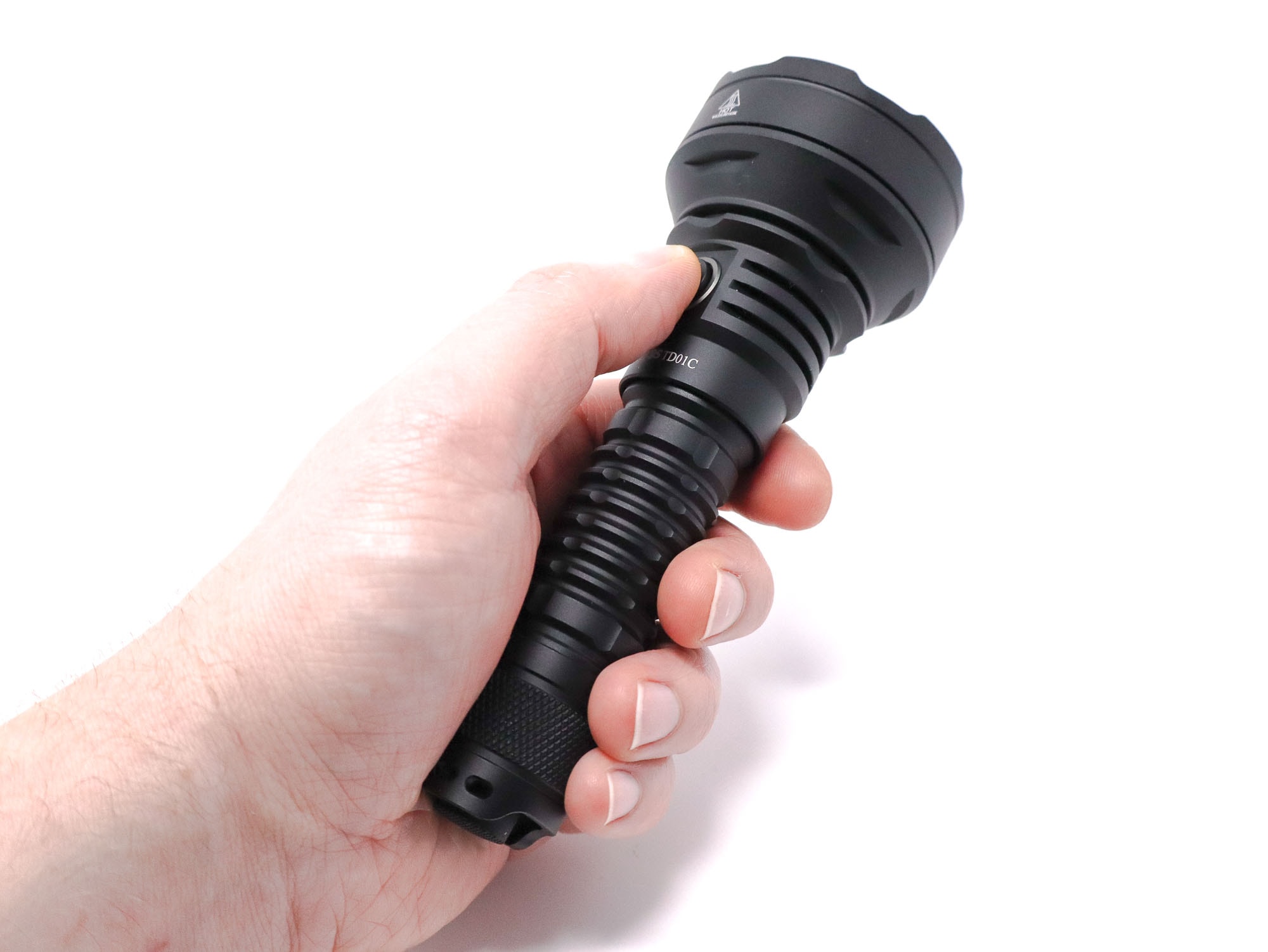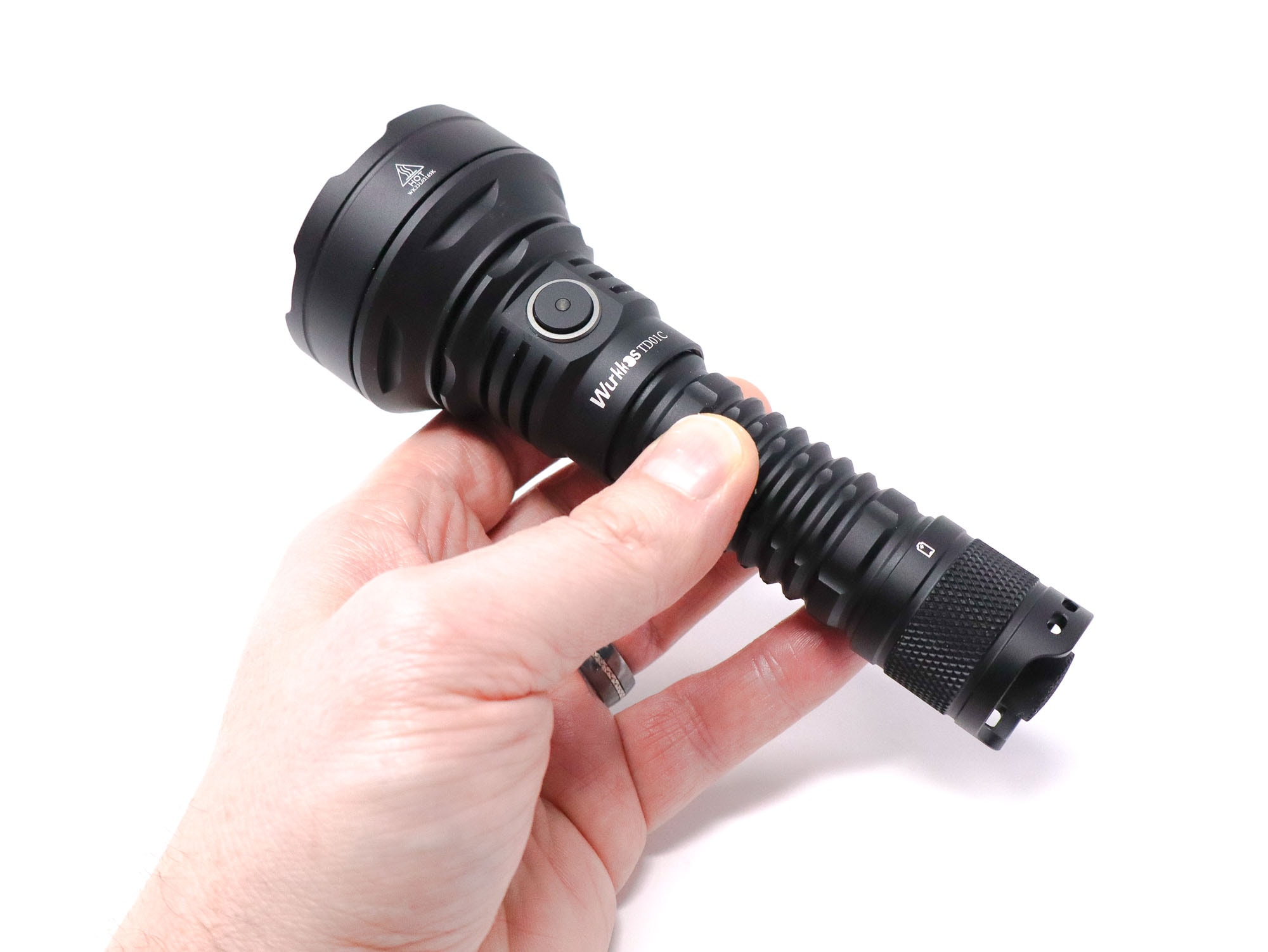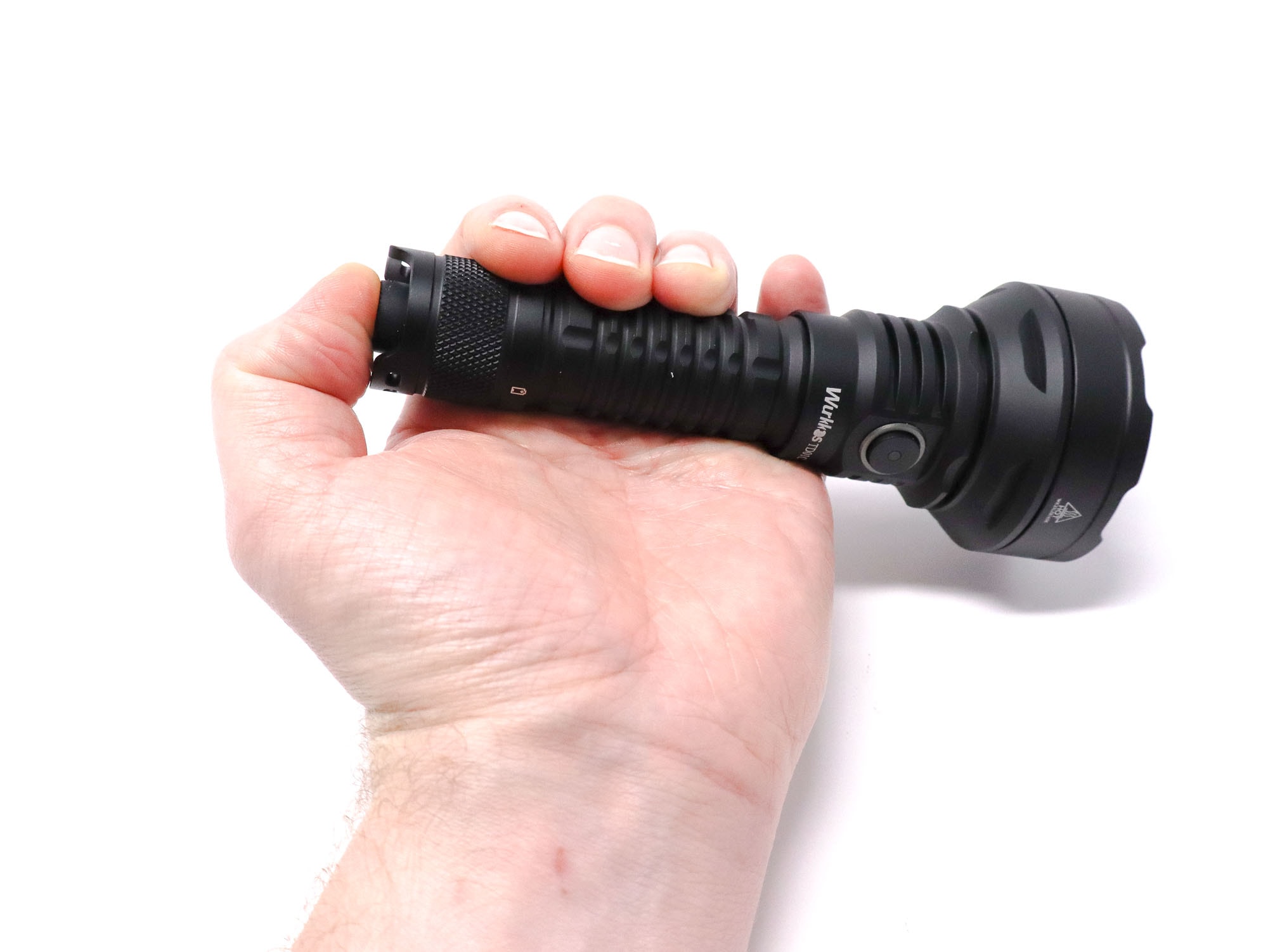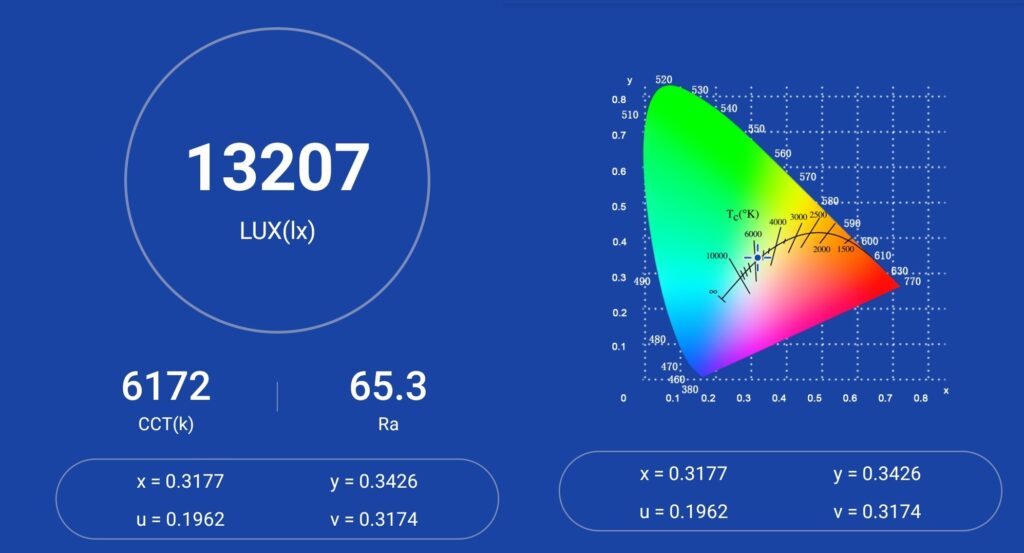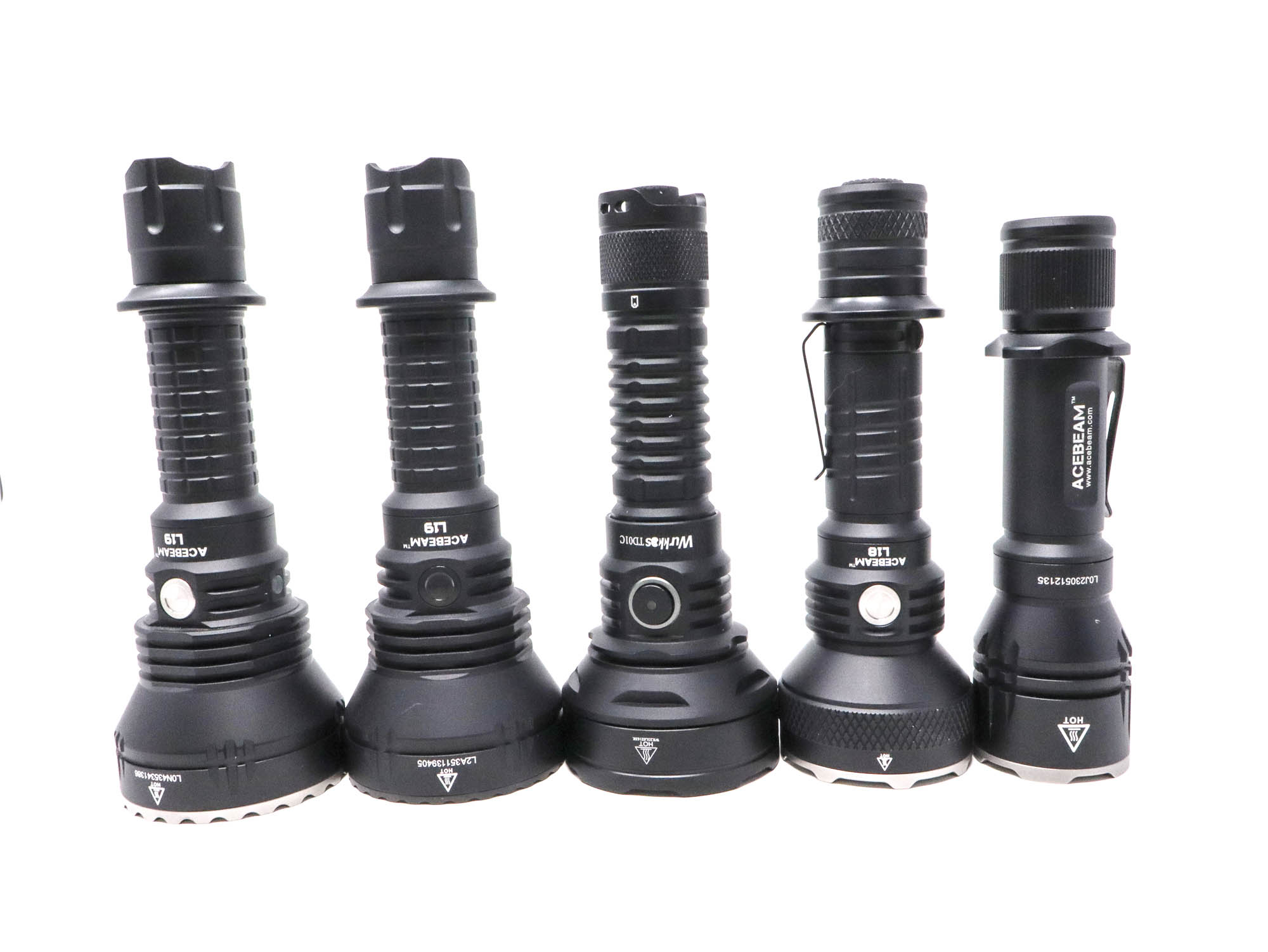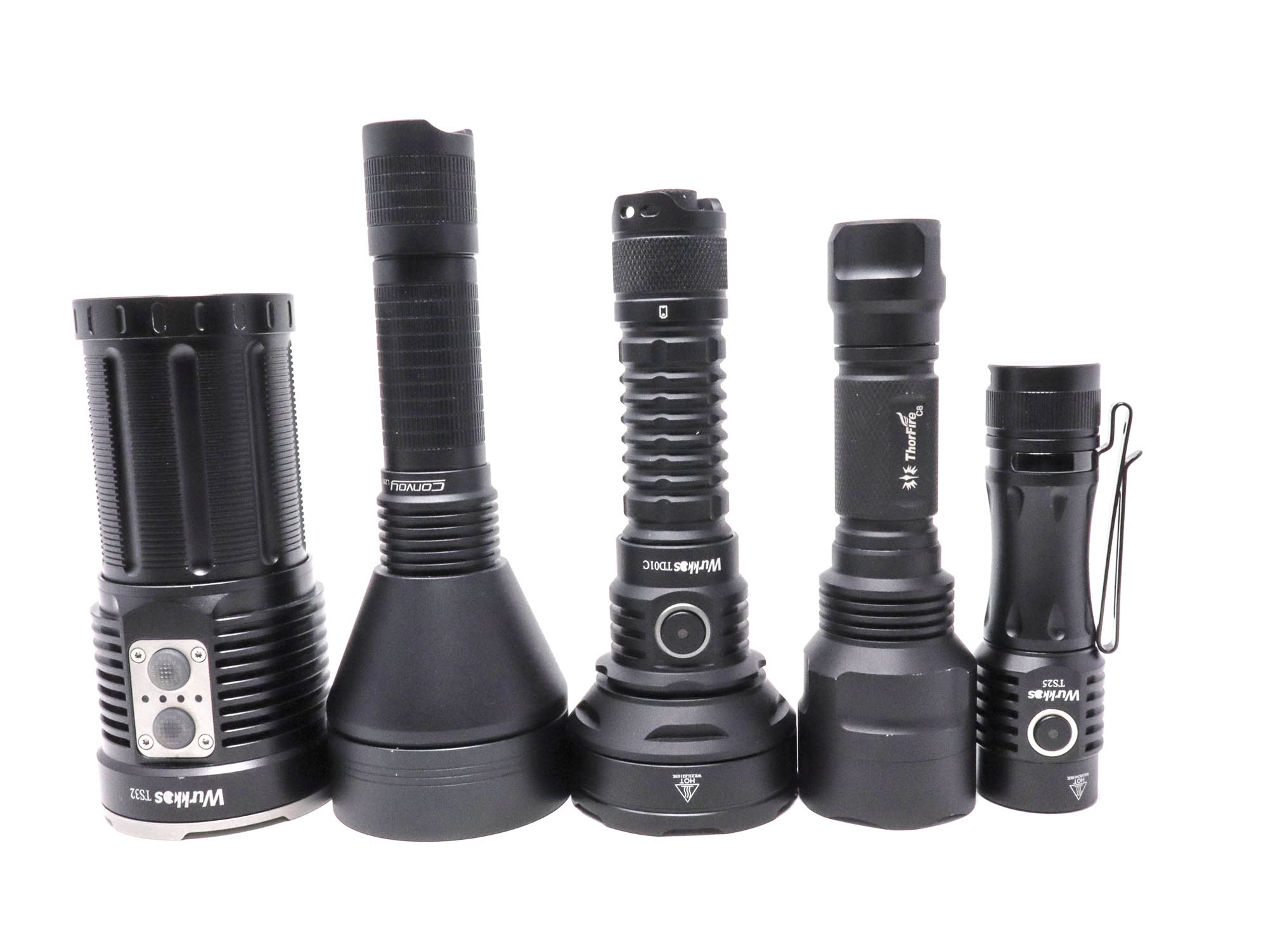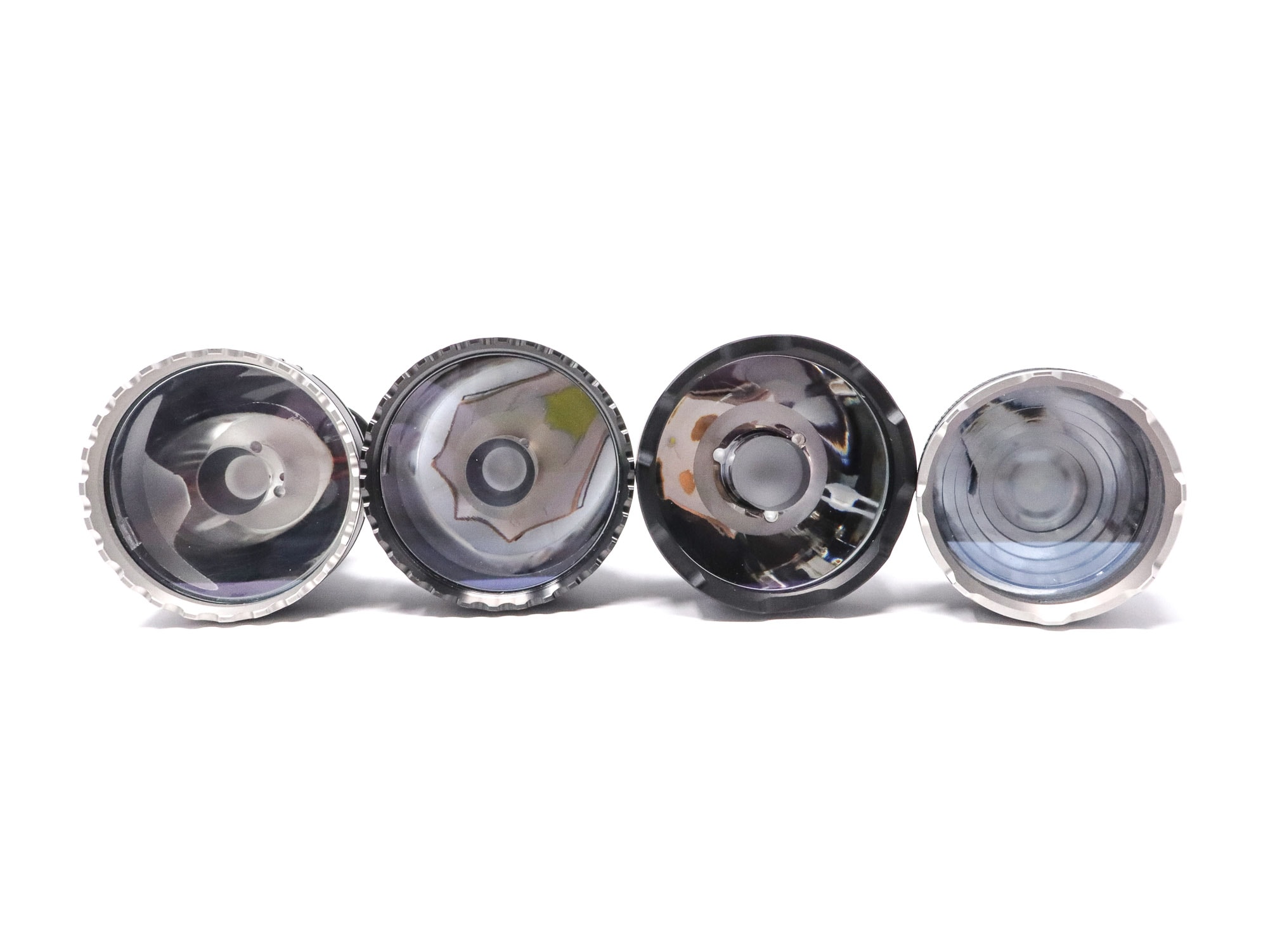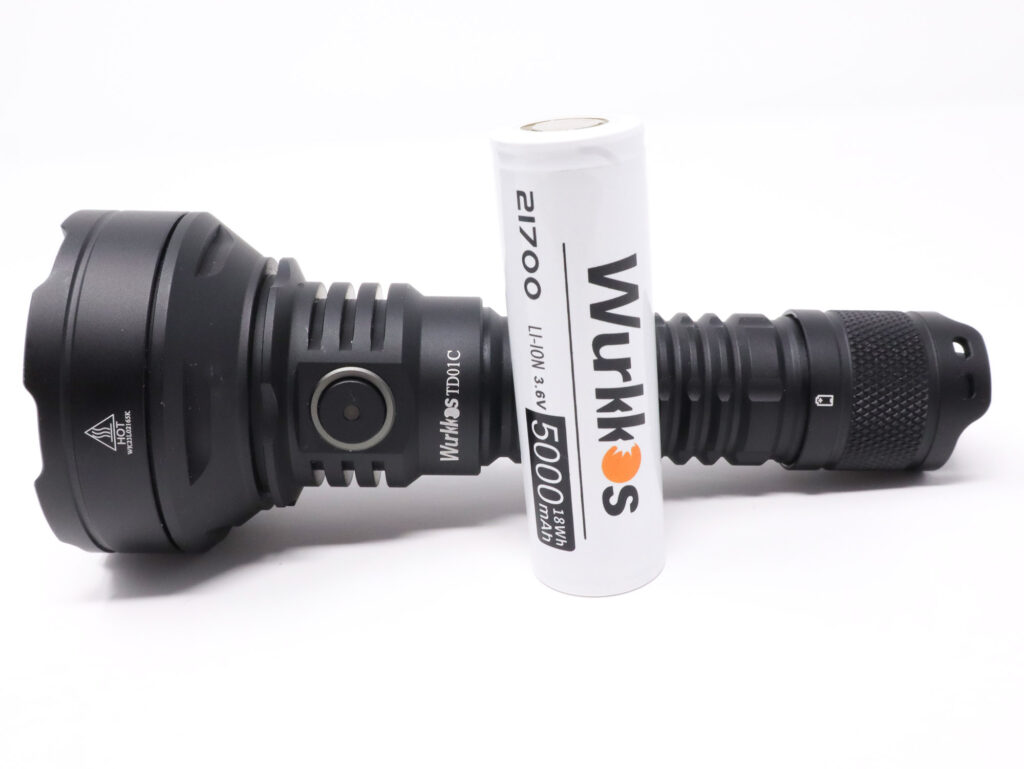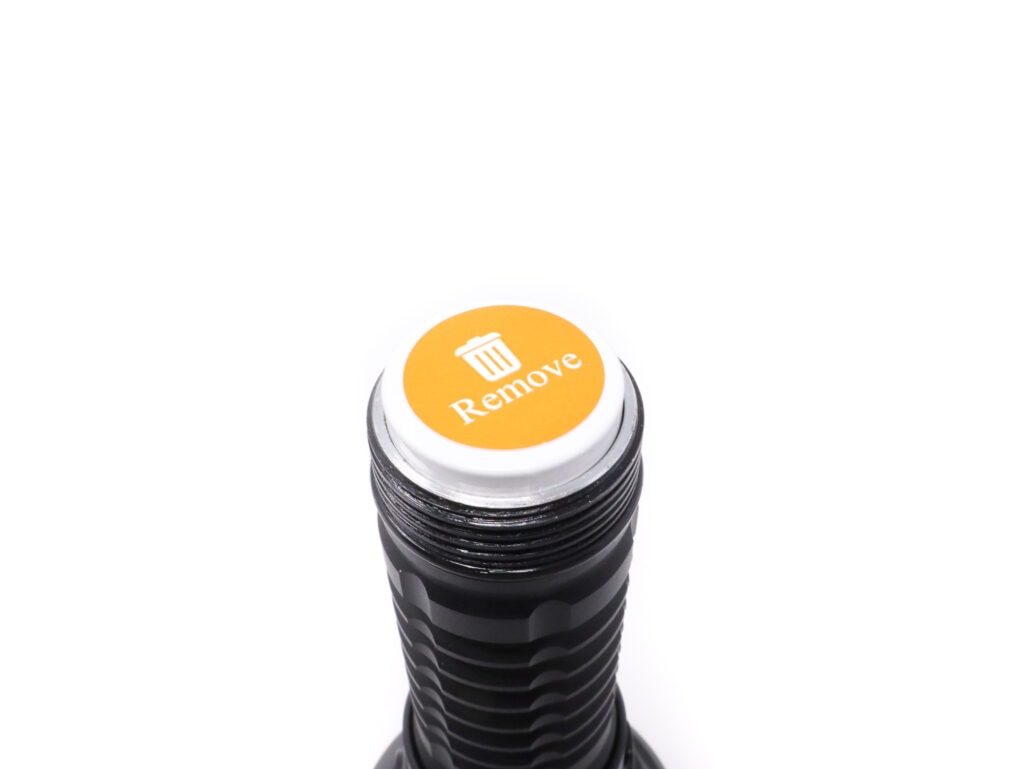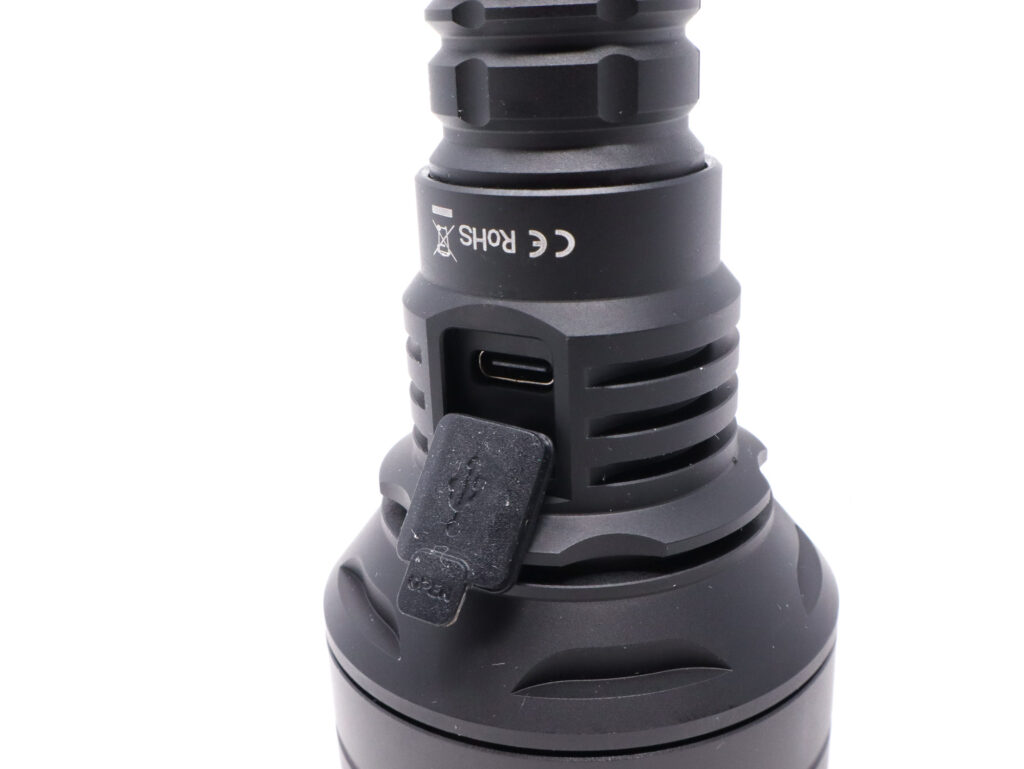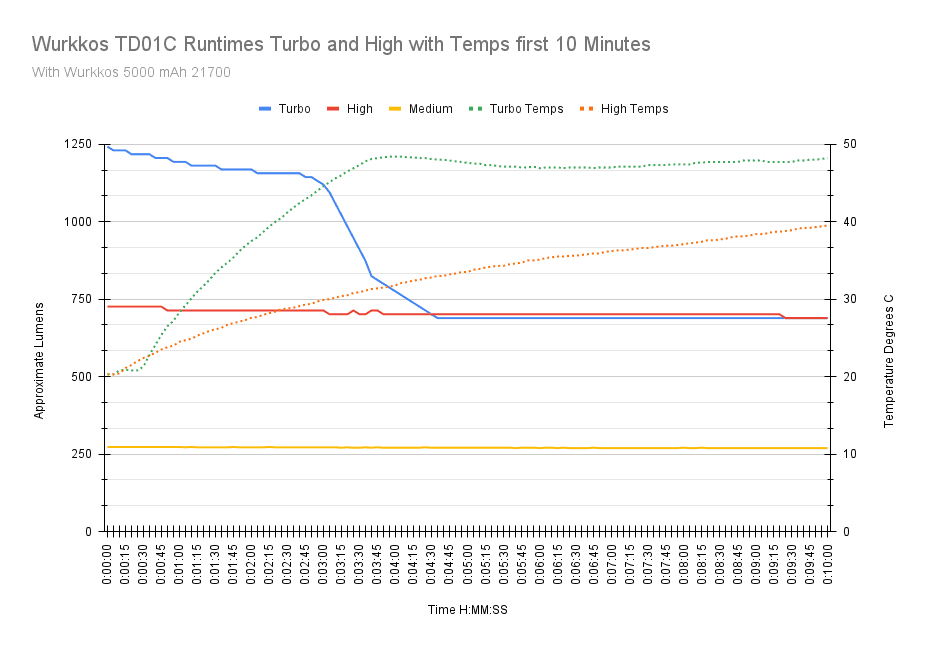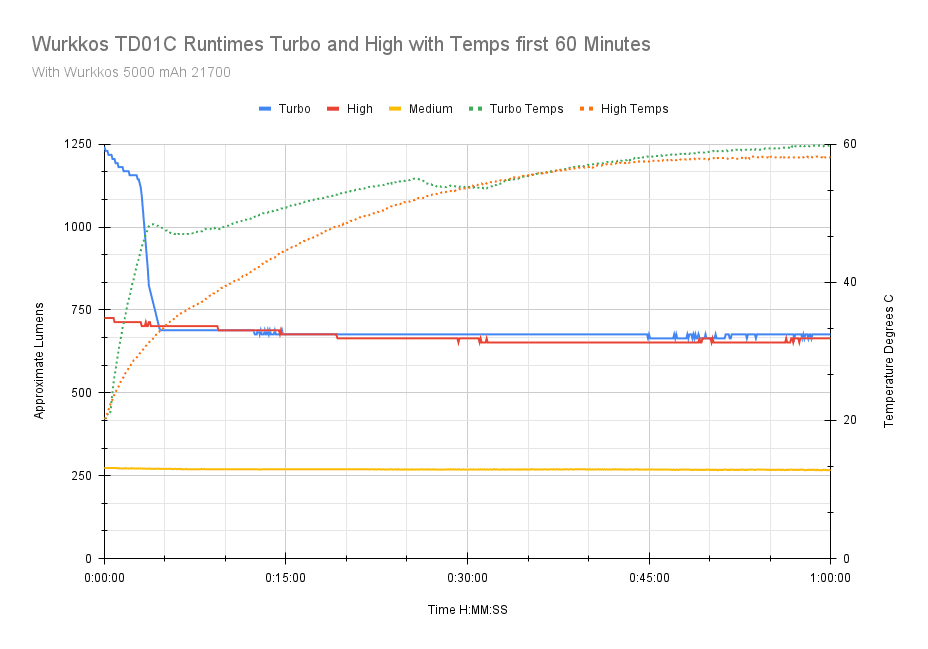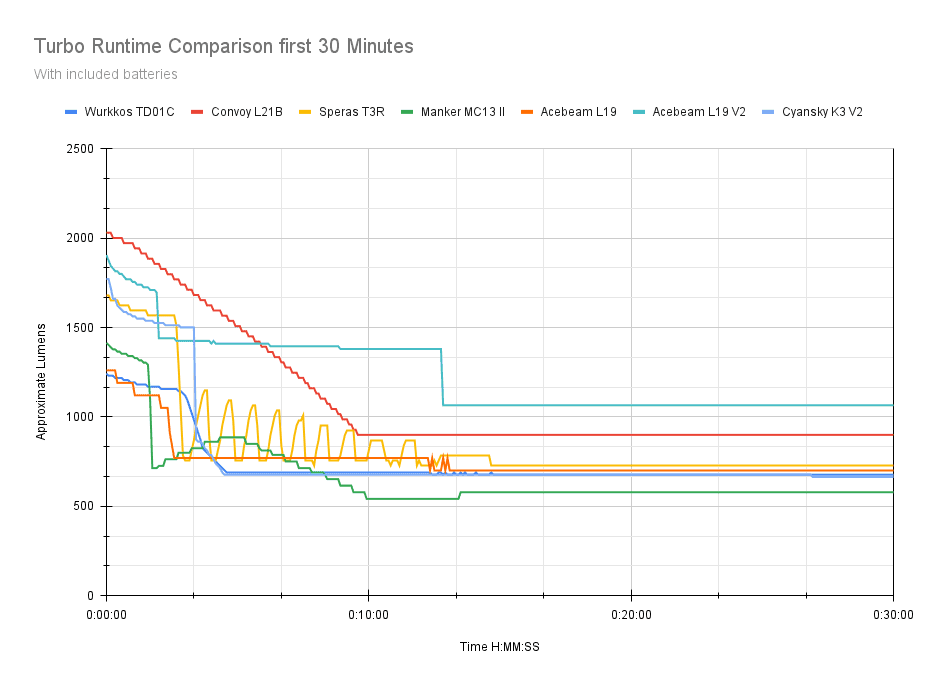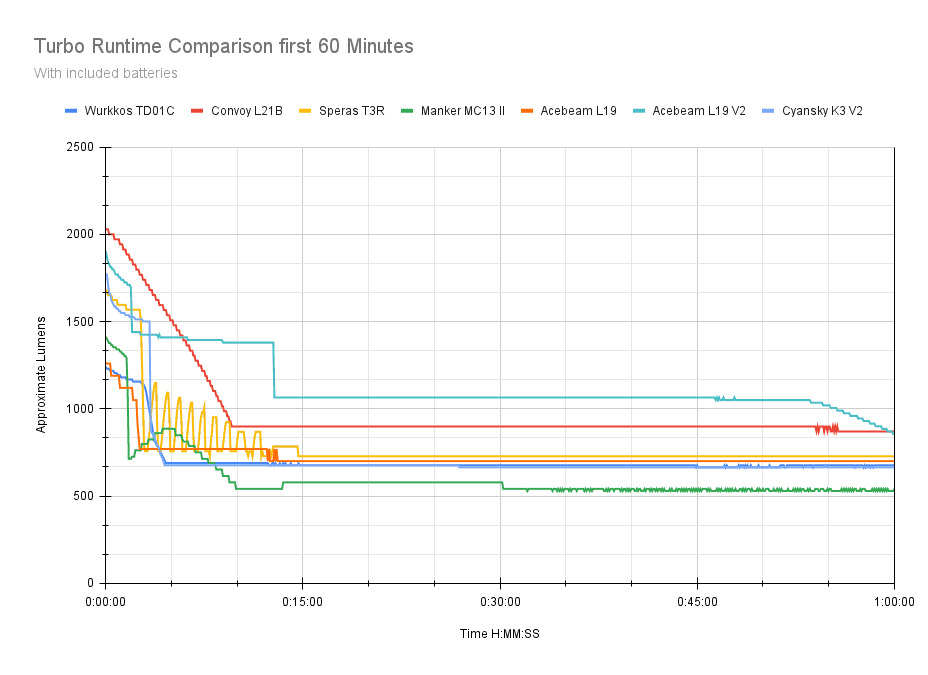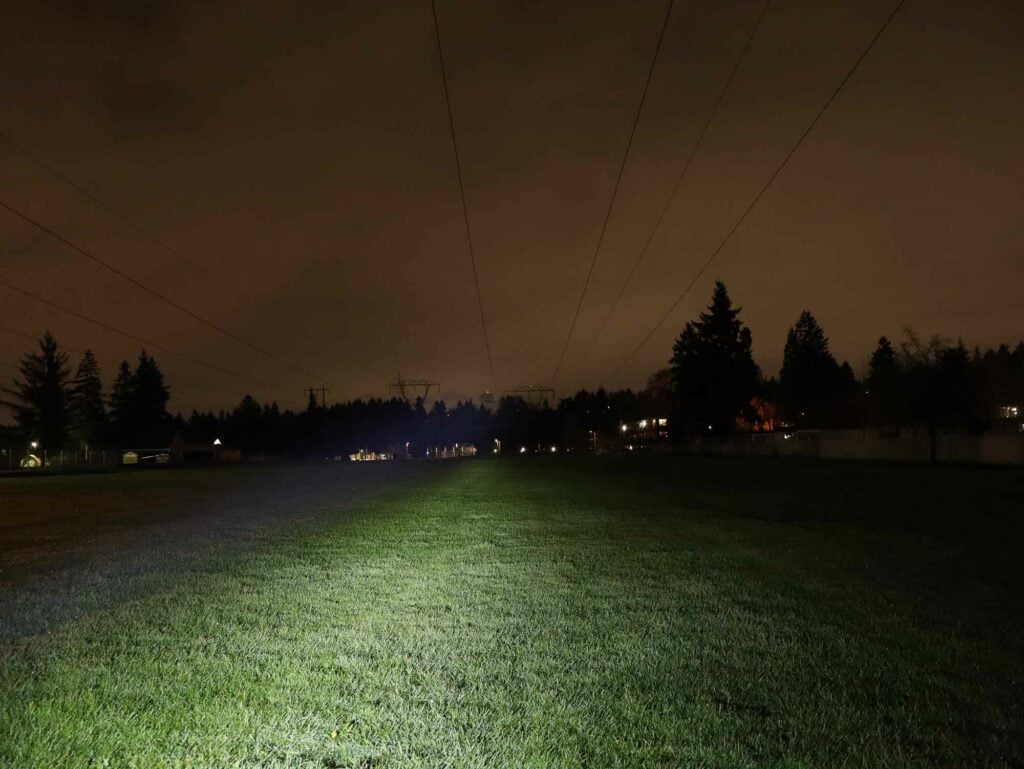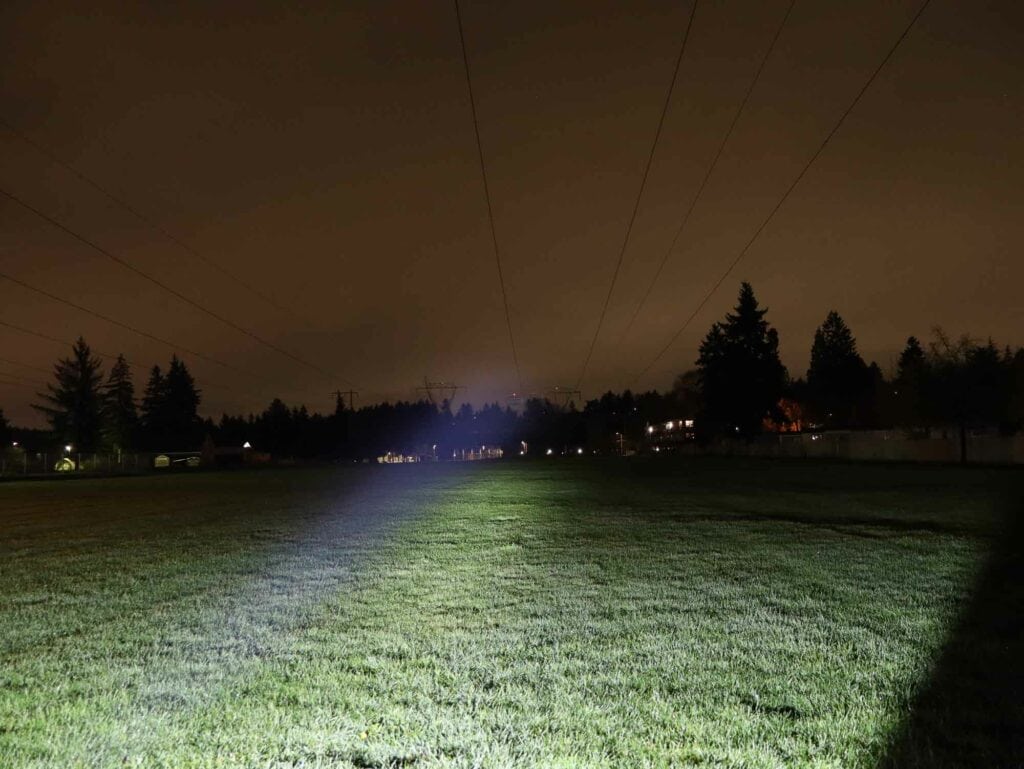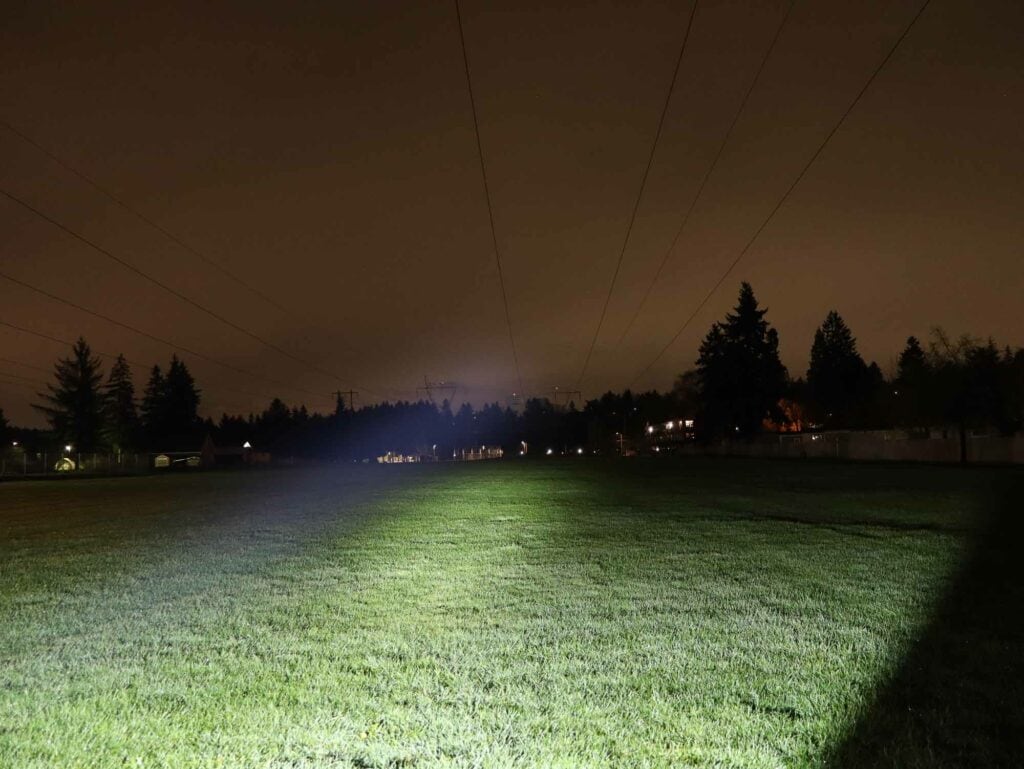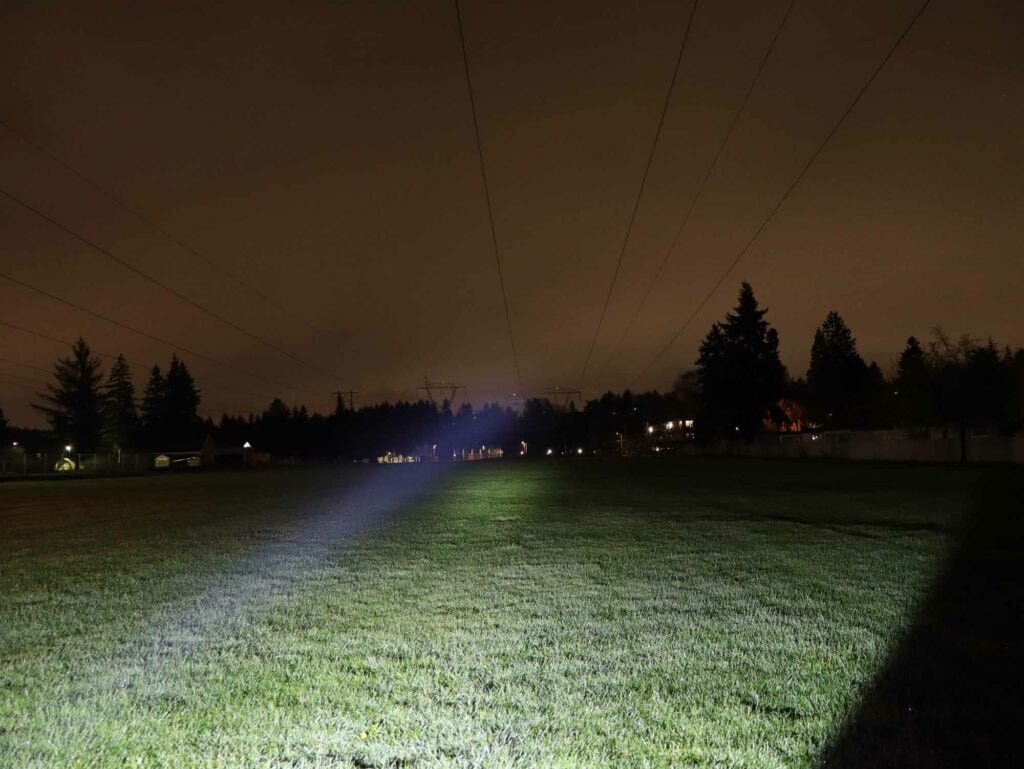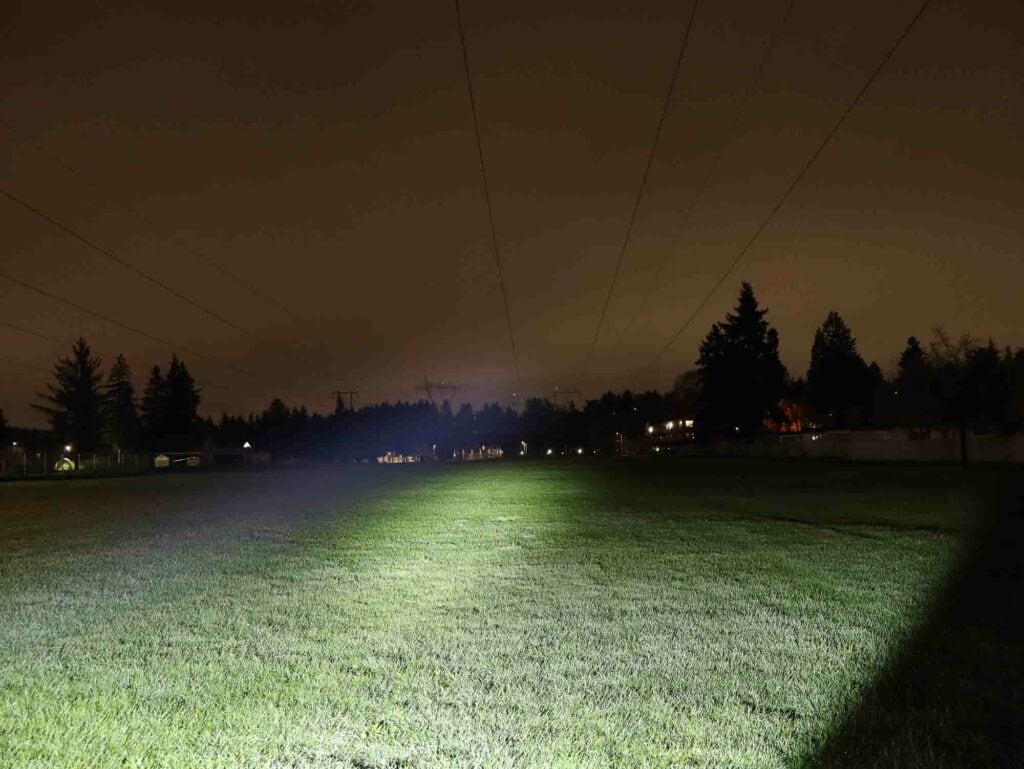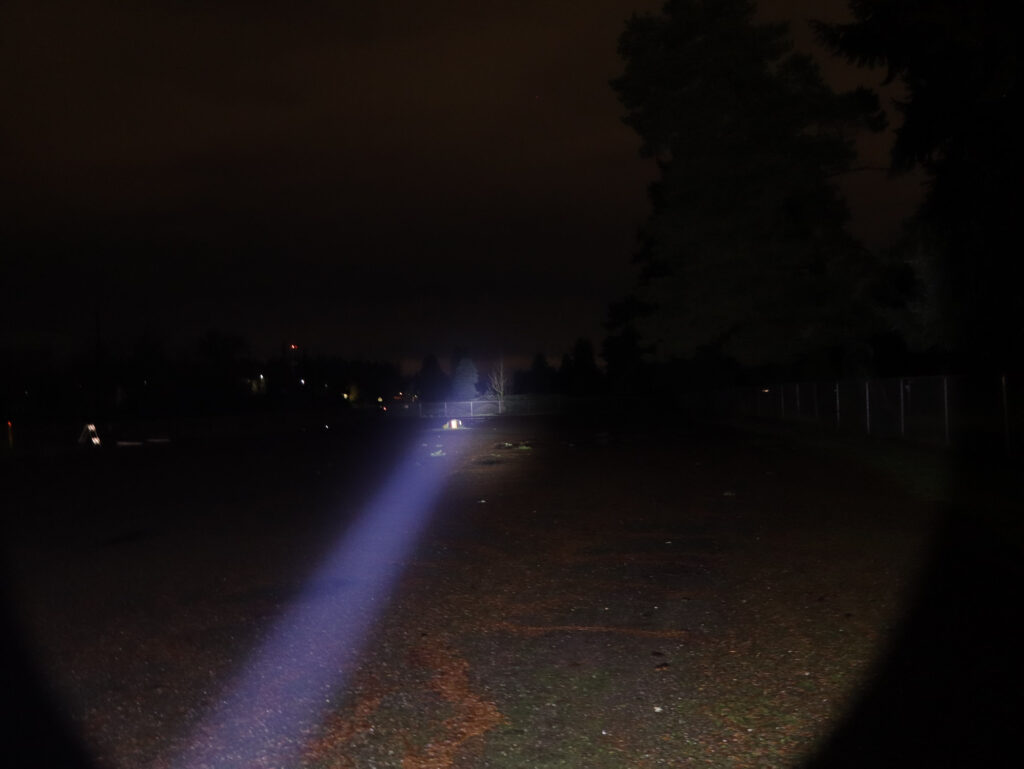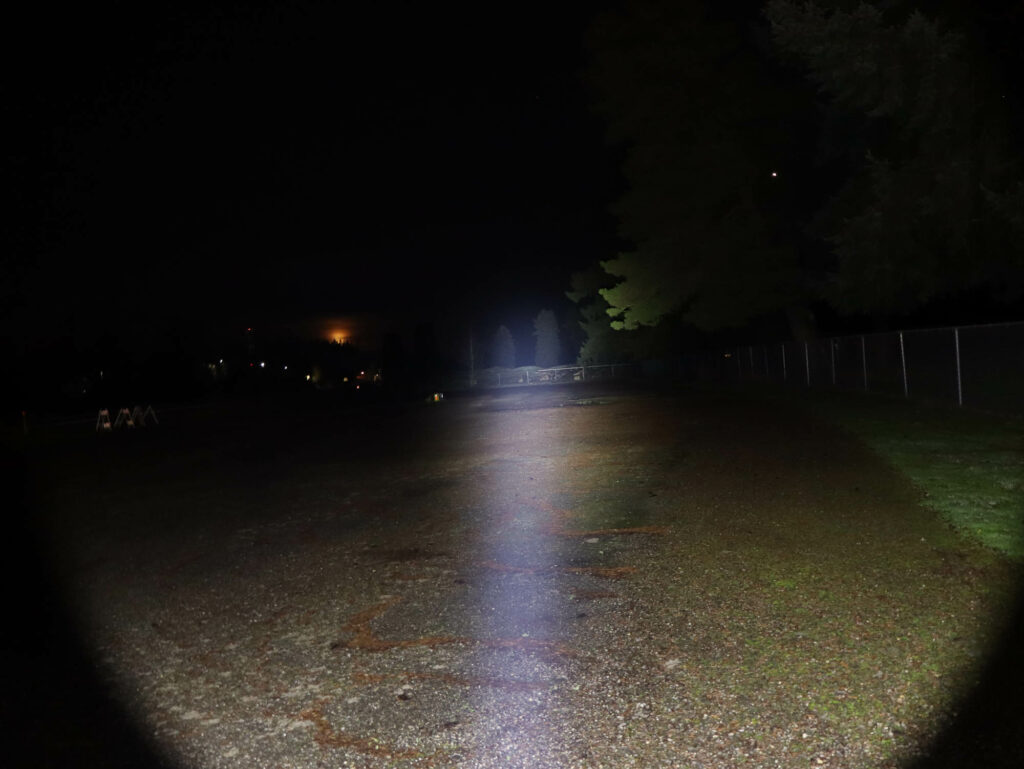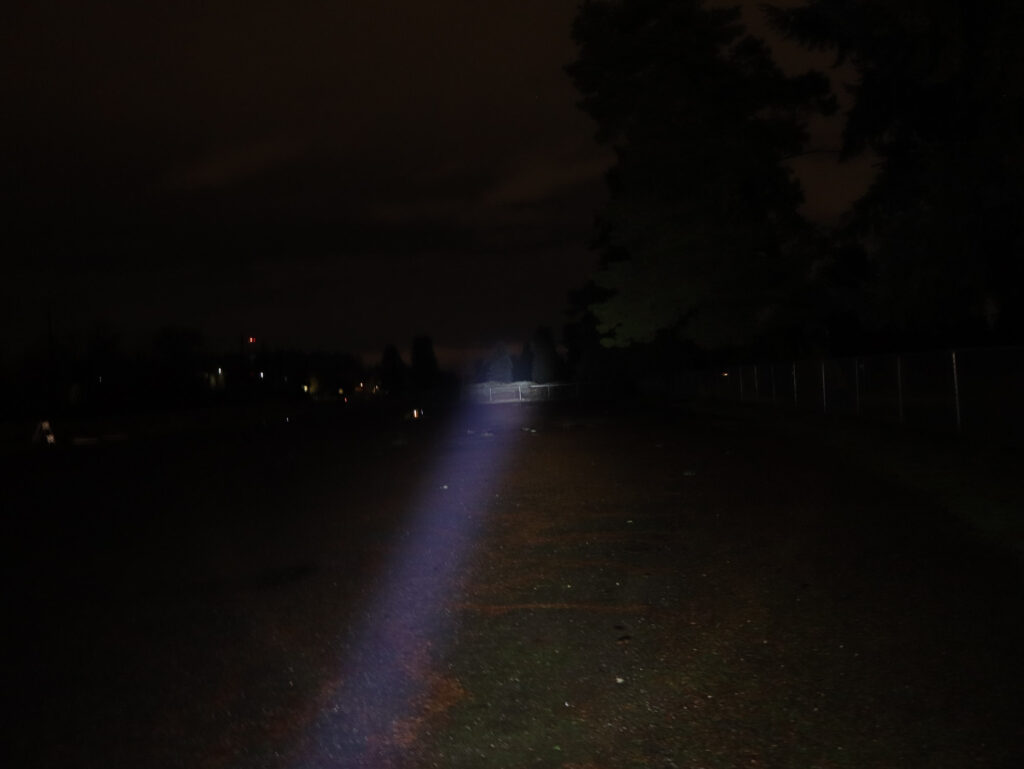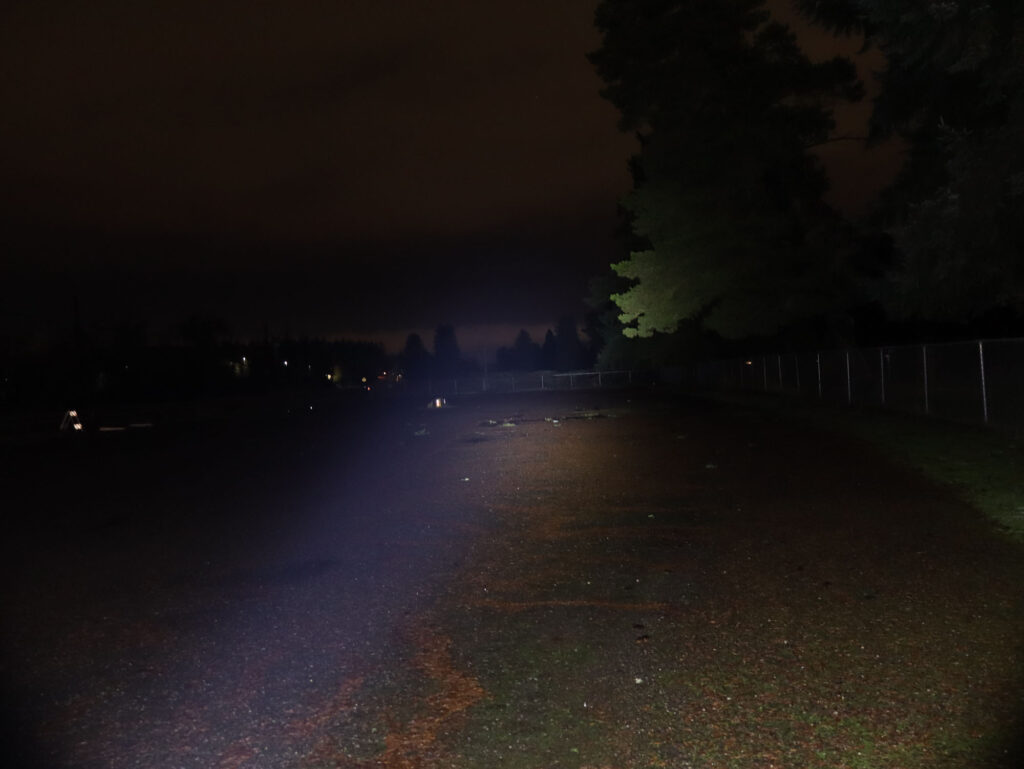1lumen selects and reviews products personally. We may earn affiliate commissions through our links, which help support our testing.
Wurkkos TD01C review
Wurkkos TD01C specs
| Brand & Model | Wurkkos TD01C |
|---|---|
| Flashlight category | General Purpose/Tactical Thrower |
| LED | Luminus SFT-40-W |
| Max. output | 1800 lumens |
| Max. beam distance | 1,000 meters |
| Max. beam intensity | 270,000 cd |
| Battery config. | 1*21700 |
| Onboard charging | USB C |
| Main modes | 5 |
| Blinkies | Strobe, S.O.S Beacon |
| Waterproof | IPX8 |
| Review publication date | January 2024 |
Review intro:
Just when you thought Wurkkos was finished with their flashlight continuum shakedown, they’ve gone and released another (well not entirely new) flashlight. In case you’ve been under a rock for the last year, Wurkkos has had a bit of a Renaissance with a complete revamping of their product lines, producing lights people seem to like, and they haven’t left flashlight fans in the dark (so to speak) either, since they flash the newest versions of Anduril, add enthusiast-centric LEDs like the Nichia 519A in high CRI and nice CCTs, all while keeping them affordable…really affordable.
The magnum opus of their endeavoring is the TS10-a dinky triple LED 14500 light that’s taken the market by storm. Everyone and their best friend’s dentist seem to have one (no, I don’t have one yet…sad I know). However, I’ve reviewed the TS32 and TS25, and the renewed TS30S Pro, and found them to be solid lights for the price, performing like more expensive lights.
The subject of today’s review is one born out of customer request, and Wurkkos is one of those companies that goes above and beyond to give buyers what they want. The TD01 (which shares a design footprint with the Sofirn SF26) is Wurkkos’ large TIR tactical-style thrower light, and while not an exact analogue, it seems to take a jab at Acebeam’s L19 V2.
The issue? It came with a FET driver, which was good for peak output, but bad for sustained output (which Acebeam’s light has-and a great one). The solution? Add a fully regulated driver, and Wurkkos did that, stuck a C on the end, and voila! The TD01C was born, promising higher sustained output thanks to the buck driver. Let’s see if this can hang with the L19 V2 (at 50% of the price).
Package quality.
The TD01C came in a nice box with an outer sleeve and a sturdy cardboard box with nice white wrapping and a magnetic closure flap. Inside you get a light in cut foam and some accessories:
- Wurkkos TD01C
- Wurkkos-branded 5000 mAh 21700 li-ion battery
- USB C charging cable
- Lanyard
- User manual
- Setup card
- 2 o-rings
This is a complete, ready to go kit. You would want to fully charge the battery to get the most runtime and output, since it came at a nice storage voltage of 3.63 volts. No charger needed either, just plug and go. Remove the insulator under the tailcap though or it won’t charge (or turn on!).
Flashlight in use, Build Quality, and Warranty
The Wurkkos TD01C is a long-range tactical flashlight like the Acebeam L18 and L19, and while you can use it as a general purpose light, it’s better as a thrower. I wouldn’t necessarily call it truly tactical or duty-ready though since it seems a bit light duty (but there are some nice features…read on for those). As a 21700 size light, the tube is delightfully nice to hold. It’s the perfect size for a lot of hands, and it’s covered with grippy nobbles for a secure grip.
The tailcap also has a band of diamond-cut knurling for extra grip as well, and I appreciate that (plus it looks cool). The tailcap has two lanyard holes on one of two ‘ears’ cut out so your thumb can access the tail switch.
Speaking of switches, there’s two: An e-switch up front and a rear forward-clicky out back. The clicky is meant for momentary use or on/off only, and the e-switch changes modes. The clicky has a nice feel and solid clicks so long as you click it positively. Clicking with a slight deviation left or right results in a notchy take up. The boot is proud and very grippy as well. However, the e-switch wasn’t as nice, with a soft, pogo-y feel with clicks that weren’t so positive. There’s about a 0.8 mm takeup before the click. This is good for preventing accidental activation, but with a clicky tailcap that’s not an issue here. It did stick up though, and was easy to find by feel.
Opposite the switch is the USB C charging port. Wurkkos raided the Sofirn parts bin for the cover since it’s covered by the same rubber cover I’ve seen on other Wurkkos/Sofirn products (like the TS, EC, SP series). I was never a fan of this design. It works and makes a good seal, but it’s difficult to fully seat and the tab still gets caught on stuff and may cause the cover to dislodge partially-enough to let water or detritus in and that’s no bueno.
Wurkkos is a budget brand, but they’ve been putting effort into improving quality of late, and I must say, quality-wise, the TD01C is darn good here. No complaints whatsoever. The parts fit together precisely with no gaps, and nothing’s misaligned either. Price? The addition of the more expensive buck driver adds about $4 US to the price versus the TD01, so expect to pay about $40 (with a battery) for the TD01C. Compared to the Acebeam L19 V2, the TD01C represents a 50-60% discount.
The TD01C is milled from 6061 T6 aluminum alloy, and the machining, fit, and finish are excellent. The edges are all chamfered and smoothed, and the silkscreen text and laser-etched graphics are crisp and sharp with nice contrast against the finish. The TD01C comes in grippy matte black anodizing. It’s comparable to Acebeam and you readers know it’s one of my favorites. It’s advertised as ‘military grade specification’ type III HA anodizing. Not sure about ‘military grade specification,’ but it’s a nice finish nonetheless and a step above my other Wurkkos lights.
The tube is a one-piece affair that doesn’t use a signal tube for the e-switch, which is nice since it eliminated a potential failure point. You can unscrew the tube and tailcap, but I gave up unscrewing the bezel with my meat mitts, then my shirt after some grunting sounds since it’s glued or Loctited.
There’s a single o-ring sealing the tube front/rear, and being glued up nets a IPX8 rating, and good for temporary immersion protection and 1 meter drops. The front and rear threads are rectangular cut, fully anodized, well-lubed and decently smooth, never feeling like they’d cross-thread.
The battery tube is not reversible, and the back end has thicker walls than the front. Hey, there’s two springs here! One for the tailcap and one for the driver in the typical ‘working light’ configuration. Two are better than one since it helps protect the driver from shock and ensures constant pressure for a solid electrical contact. The rear spring is a dual-coil spring design for lower resistance (looks identical to the Astrolux EC03).
For the warranty, it’s not bad at all for a budget light. From Wurkkos: Within 30 days of purchase: Contact the original seller for repair or replacement. Flashlights: Within 1 year of purchase: Contact wurkkos for repair or replacement accessories. In the first instance we attempt to resolve the issue. In the unlikely event of a faulty product we may advise customers to return the product to wurkkos for repair or replacement. Please Note: This warranty does not cover normal wear and tear, modifications, misuse, negligence, accidents, improper maintenance, or repair by anyone other than an Authorized retailer.
LED, Lens, Bezel, Beam, and Reflector
The LED is the Luminus SFT-40-W. This LED has been around for a while and solidly established itself as the premier, go-to high intensity, high output flashlight LED. Although competitors are popping up from Chinese manufacturers (actually from Luminus’s owner San’an Optoelectronics), the SFT-40-W is still the one to beat. It’s a 5050 (5 mm x 5 mm) footprint domeless high output LED. The LES is 4 mm2, and it’s a bond wire design, so not the current CSP topology, but it’s still an efficient LED that can take a lot of amps, way more than the Osram Boost HX.
With a 0.7 ℃/W thermal resistance for the 6500K version, at 700 mA Luminus claims 171 Lm/W. That’s a lot, and this LED is capable of over 2100 Lumens at 8 amps, but can be driven much harder with good cooling. The TD01C comes with the cool white version. These are TIR based lights, with large PMMA plastic TIR lenses like the Acebeam L19 lights. They look almost identical to the Acebeam TIRs. I measured it at 50.8 mm wide. The optic is protected by a hardened mineral glass AR coated lens. The bezel is advertised as stainless, and I can’t refute it, but it’s a large unit with crenulations that extend about 4 mm over the lens to protect it from impacts. The beam is what I expect from a TIR thrower-less spill than a reflector, but still a good amount.
There’s a bright hotspot that’s quite a bit bigger than the SFT-40-W L19 V2. It could be used for general purpose use and thrower duty, but it’s not as clean as the Acebeam beam since the TD01C hotspot isn’t super-tight, and the spill has a very obvious bright ring in the beam. It’s not too distracting though, but noticeable.
Spectral measurements:
I used the Opple Lightmaster Pro to measure the flashlight at 3 meters from the sensor.
| Mode: | CCT: | CRI Ra: | duv |
|---|---|---|---|
| Turbo | 6172K | 65.3 | 0.0076 |
Dimensions and its competition
Dimensions:
| Wurkkos TD01C | Millimeters | Inches |
|---|---|---|
| Length | 152 mm | 6 in |
| Head diameter | 59 mm | 2.3 in |
| Optic diameter | 50 mm | 2 in |
| Tube diameter | 26 mm | 1 in |
Dimensions are rounded to the nearest millimeter, and to the nearest tenth of an Inch.
Weight:
| Wurkkos TD01C | Weight in grams | Weight in oz |
|---|---|---|
| Without battery: | 196 g | 6.9 oz |
| With battery | 264 g | 9.2 oz |
Weight is rounded to the nearest gram, and to the nearest tenth of an Oz.
Flashlight size comparison with its competition:
Group 1 left to right: Acebeam L19, Acbeam L19 V2, Wurkkos TD01C, Acebeam L18, Acebeam L17
Group 2 left to right: Wurkkos TS32, Convoy L21B, Wurkkos TD01C, Thorfire C8, Wurkkos TS25
Group 3, reflectors left to right: Acebeam L19, Acbeam L19 V2, Wurkkos TD01C, Acebeam L18
Wurkkos TD01C UI: User Interface and Driver
This is what makes the TD01C special. The driver in the C model has been updated from the regular TD01 to a fully regulated buck driver. The non-C model has a linear FET driver. The buck driver is a pretty nice upgrade, and while the FET driver guarantees higher output initially, the buck driver will give higher regulated output, Wurkkos claiming figures 50% higher than the standard light.
The UI has been mostly lifted from the Wurkkos TD04, Wurkko’s other rear clicky e-switch light. It has 2 mode groups:
Group 1 ‘Stepped Mode’ has 5 modes plus Moon, Turbo, and 3 blinkies for more general purpose use.
Group 2 ‘Tactical Mode’ has fewer modes and rearranged Turbo/Strobe functions for tactical or duty-use. This is something found on higher-end lights like Fenix or Acebeam or Nitecore, so to see it on a Wurkos is nice. Note the TD01’s UI nixes the Moonlight mode.
To switch from Stepped Mode to Tactical Mode: From ON press and hold the e-switch for 4 seconds. The light switches to either Turbo mode if switching from Stepped mode to Tactical, or Eco if switching to Stepped Mode.
Available modes in Stepped Mode:
- Moonlight, Eco, Low, Medium, High, Turbo
Available modes in Tactical Mode:
- Medium, Turbo
Available blinky modes (both mode groups):
- Strobe, S.O.S, Beacon
From OFF in Stepped Mode:
- Single click rear clicky: Turns on in last used brightness
- Tap rear clicky: Momentary on in last used brightness
- Press and hold e-switch while clicking rear switch: Moonlight
- Tap then fully click rear switch: Turbo
From ON in Stepped Mode:
- Single click rear clicky: Turns off
- Single click e-switch: Changes modes E-L-M-H-E
- Double click e-switch: Turbo
- Triple click e-switch: Strobe. To switch between S.O.S and Beacon, double click the e-switch
From OFF in Tactical Mode:
- Single click rear clicky: Turns on in Turbo
- Tap rear clicky: Momentary on in Turbo
- Tap then click rear switch: Strobe. Double click while in Strobe to switch between S.O.S and Beacon
From ON in Tactical Mode:
- Single click rear clicky: Turns off
- Single click e-switch: Switches between Medium and Turbo
- Double click e-switch: Strobe. While in Strobe, double click to switch between S.O.S and Beacon
Mode memory:
- For Stepped Mode ONLY: Remembers the last use mode. Turbo and the blinky modes are not memorized
Shortcuts:
- Double click e-switch (Stepped Modes): Turbo
- Double click e-switch (Tactical Modes): Strobe
- Tap then click the rear switch from OFF (in Stepped Mode only): Turbo
- Triple click e-switch (in Stepped Mode only): Strobe
Low voltage warning/protection:
- The switch LED indicated battery state when turned on for 5 seconds:
- Solid green 50% to 100%,
- solid red 50% to 20%,
- flashing red less than 20% remaining battery
Strobe/blinkies
- Strobe, S.O.S, Beacon
Lock-out mode:
- Manual lockout: Unscrew the tailcap 1/8
PWM
- None
Additional/summary info on the UI:
- This is a pretty awesome and well-implemented UI for a budget light, and even caters to the tactical/duty-use crowd with instant Turbo and (more or less) instant Strobe for those brave enough to carry it on their duty belt or loadout. I like it as much as the L-series from Acebeam even. You get two mode groups to suit the use-case, and the mode spacing for each is good. I like the addition of Medium-Turbo for the Tactical Mode, and the Stepped Mode has nicely spaced brightness also.
- I really don’t have any qualms here and it doesn’t misbehave or have any wonky modes or umpteen button clicking procedures or press-and-hold routines for regular mode switching. You can leave it in the Stepped Mode and be on your way, or if you want two modes, switch to Tactical Mode. Wurkkos says the TD01C has intelligent temperature regulation and LVP on board.
Wurkkos TD01C Charging and batteries
The Wurkkos TD01C takes a 21700 size battery like pretty much every modern light in 2024. These cells have pretty much dominated the market now, and for good reason: You get the capacity of 26650s in a 21 mm diameter cell, much higher current-handling capability, and lower internal resistance and high energy density.
The tester came with a Wurkkos-branded 5000 mAh 21700 cell. I don’t know who makes this one, but it’s either a BAK or Lishen cell. This is a flat top unprotected battery, and the VapCell S4+ has it at around 21 milliohms for internal resistance, so good for about 20 amps or so. Thanks to the dual springs, the TD01C handled every 21700 I threw at it besides the ultra-long Acebeam 21700s with button tops and internal charging.
You get onboard USB C charging, good for 5 volts 3 amps. After the runtimes, the average capacity added was about 4100-4200 mAh in about 3 hours. Ending voltage was a conservative 4.13 volts.
| Charge type | Fits | No fit | Charge time |
|---|---|---|---|
| USB type C | Protected, standard, flat and button top 21700 | Very long protected, integrated charging button tops | Around 3 hours |
Performance test
Lumen measurements
How Lumens are Measured: Understanding ANSI FL1 Standards How Lumens are Measured: Understanding ANSI FL1 Standards: The ANSI FL1 standards specify that output in lumens should be measured 30 seconds after turning on, as this is the standardized time for measuring brightness according to the industry standard. This is why we focus on this part in our measurements. The ANSI FL1 standards require an ambient temperature of 22 ± 3°C. We record the ambient the ambient temperature to identify potential reasons for any observed discrepancies.Lumens are measured in my 50 cm integrating sphere with a Digi-Sense 20250-00 data logging luxmeter. The sphere has been calibrated with a Convoy S2+ measured to 260 Lumens and the figures are within 10% of actual. No current measurements this time due to the weird current path. Measurements were taken using the included fully charged 5000 mAh battery.
| Mode | Specs | turn on | 30 sec | 10 minutes |
|---|---|---|---|---|
| Moonlight | 1 | N/A | N/A | – |
| Eco | 30 | 22 | 22 | – |
| Low | 150 | 114 | 114 | – |
| Medium | 350 | 273 | 273 | 269 |
| High | 800 | 726 | 726 | 669 |
| Turbo | 1800 | 1242 | 1218 lm | 669 |
Parasitic drain:
- N/A
I wasn’t expecting spectacular output from the TD01C for two reasons: It’s using a fixed-current buck driver (no FET/direct drive), and you lose more light out the front with a TIR than a reflector (I’ve tested similar lights with this LED with reflectors, so see the comparison graphs below). Moon gets pretty low. I can usually measure down to about 1 Lumen, but it’s not even registering on the luxmeter!
Wurkkos TD01C Battery Life: Runtime graphs
How Runtimes are Measured: Understanding ANSI FL1 Standards About ANSI FL1 runtime standards: The runtime is measured until the light drops to 10% of its initial output (30 seconds after turning on). This does not mean that the flashlight is not usable anymore. The last column shows how long the light actually works till it shuts off. If there is a + symbol, it means that the test was stopped at that particular point, but the light was actually still running. This happens on certain occasions, with certain drivers, firmware, or batteries.Lumens are measured in my 50 cm integrating sphere with a Digi-Sense 20250-00 data logging luxmeter. The sphere has been calibrated with a Convoy S2+ measured to 260 Lumens and the figures are within 10% of actual. I use a Digi-Sense 20250-92 data logging thermocouple for the temperature measurements. The probe is affixed to the head using kapton tape and uses the same 5 second sampling rate for logging. I used the included, fully charged 5000 mAh 21700 and tested Medium, High and Turbo on the Stepped Mode group.
| Mode | Specified runtime | Measured runtime ANSI | Time till shut off |
|---|---|---|---|
| Medium | 6.5 h | 6h 50min | 6h 50min |
| High | 3 h | 2h 57min | 2h 57min |
| Turbo | 2 h | 1h 47min | 1h 47min |
The advertised runtimes for the TD01C are shorter than the TD01 (Medium 9h, High 4h, Turbo 2.5h). This is due to the buck driver holding higher output longer rather, which is always preferable, and I’ll take that over a longer runtime any day. While these aren’t spectacular, they’re not bad at all, and the sustained outputs are great for a $40 flashlight. You get a solid 2 minutes of 1000 Lumens from Turbo with 700 sustained, and High gives you the same 700-ish Lumens for over 2 hours.
This is performance in line with much more expensive lights. There’s step downs as LVP kicks in, with shutdown a short time later at predictable intervals. The light was usable after the shut downs (cycle the clicky to re activate the light) with useful brightness levels on all modes tested for a good while. The battery was discharged to 2.9 to 3 volts, so pretty conservative. For heat, it seems set around 55 to 60 C, which is fine and the light got pretty warm, but not too hot to hold. The ATR also looks really good.
The comparison graphs give us a good idea of the difference between a $40 light and a $100 light. I compared some similar SFT-40-W lights with reflectors, and the main competitor Acebeam L19 V2 (which also has an optic). The Cyansky K3 V2 and Convoy L21B, Speras T3R have higher output, with the edge going to the Convoy for sustained output. The L19 V2 is a significant upgrade over the TD01C, but you’ll pay for that performance. Hey, $40 is $40, and I’m not complaining one bit here.
Peak beam intensity and beam distance measurements
About Peak beam intensity: Understanding ANSI FL1 Standards About peak beam intensity The calculated value of distance in meters at which the flashlight produces a light intensity of 0.25 lux. (0.25 lux is about the brightness of a full moon shining on an object). This means that the intensity has decreased so much, it becomes difficult to see darker objects, or objects that don’t reflect light. The columns ‘Meters’ and ‘Yards’ use rounded numbers.Beam distances are measured using a Uni-T UT383S luxmeter measured indoors at 5 meters using the included fully charged 26980 battery. Measurements taken at 30 seconds.
| Mode | Specs | Candela measured | Meters | Yards |
|---|---|---|---|---|
| Moonlight | 207 | 150 | 24 | 27 |
| Eco | 3550 | 3625 | 120 | 132 |
| Low | 17,100 | 17,375 | 264 | 289 |
| Medium | 32,192 | 47,150 | 434 | 475 |
| High | 71,333 | 129,850 | 721 | 788 |
| Turbo | 270,000 cd | 218,875 cd | 936 | 1023 |
The Turbo figure is off from spec, but that’s okay since the rest look really good.
Beamshots
Camera settings and distance: Photos taken with a Canon EOS R100 with Canon RF-S 18-45 mm STM lens. For the 40 meter shots, the camera is set to 0.3s f5 ISO1600 and 5000K WB. For the water tower shots the camera is set to 0.5s, f4.5 ISO 1600 and 5000K WB.
Beamshots of the following flashlights compared for the water tower at 950 meters:
- Wurkkos TD01C
- Acebeam L19 V2
- Convoy L21B
- Speras T3R
- Thrunite Catapult Pro
- Fenix HT18R
Beamshots of the following flashlights compared. The fence is 95 meters away:
- Wurkkos TD01C
- Acebeam L19 V2
- Convoy L21B
- Thrunite Catapult Pro
- Fenix HT18R
Please note that the following beamshots are mainly intended to showcase the beam pattern and beam quality, rather than overall performance. These images are typically taken directly after activation, and in different seasons or weather conditions, and therefore do not fully represent its overall performance. For accurate performance metrics, such as output, beam distance, and runtimes, you need to look at the performance section of this review.
Disclaimer: This flashlight was sent to us for review at no cost by Wurkkos. We have not been paid to review, nor have we been holding back on problems or defects.
Final Verdict
Pros
- Very good build quality, fit and finish
- Great handling
- Fully regulated output
- Onboard USB type C charging
- Useful UI
- Very affordable
Cons
- Beam is ringy
- Way down on output
Explanation on star ratings:
1: Avoid: a match would be a better choice – 2: Poor: significant defect or issues; almost unusable – 3: Average: some defects or issues; but still usable 4: Good: recommended (minor issues) – 5: Great: highly recommended
4.5 stars: ★★★★★⋆
While our star rating provides a reliable indicator, we encourage you to read the full review to make an informed decision based on your own needs and preferences.
While I wouldn’t say Wurkkos has reinvented the wheel with their new lights, they certainly have progressed from making Flintstone wheels to Michelins. Moreover, they’re doing this while being very successful and selling tons of these new lights. A big contributor to this success? Listen to people who buy flashlights as to what works/doesn’t and go from there. TD01C (along with the TS32, TS25, FC series, and TS10) is the result of this input from enthusiasts and hobbyists in the flashlight community.
The Wurkkos TD01C impressed me on a lot of fronts: Regulated driver, sound build quality, fit, and finish, useful beam, a nice UI, good handling with decent throw. While it didn’t meet output specs (by a lot), I prefer fully regulated output. Also, while it’s more ‘tactical’ than some other lights, I don’t know if I’d depend on it to save my life, and the untested durability question mark looms, so the ‘tactical’ moniker goes out the window. I digress however, because for $40 (with battery), I don’t know if you can do better than the TD01C for a TIR-based long-range light.
To get better performance you’d be spending $100 on the Acebeam L19 V2. Would I buy one? If I only had $40 to spend and wanted a big TIR light, absolutely. It’s one of the cheapest ways to get into a big TIR light with a buck driver. That’s a win in my book. Bravo to Wurkkos. I’m only really docking it for the low performance, but otherwise this is a really good budget alternative to the Acebeam L19 V2. 4.5 stars for the TD01C.
Buy your Wurkkos TD01C here
1lumen selects and reviews products personally. We may earn affiliate commissions through our links, which help support our testing.
